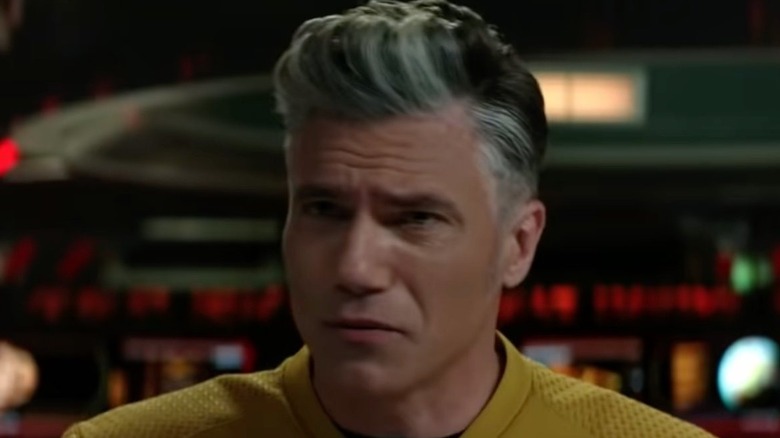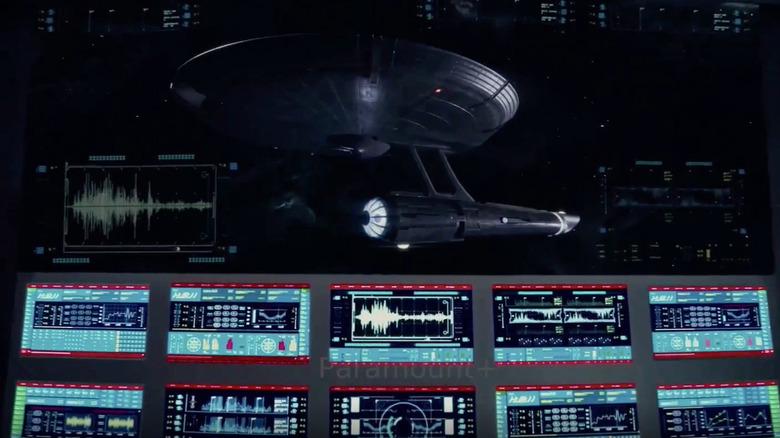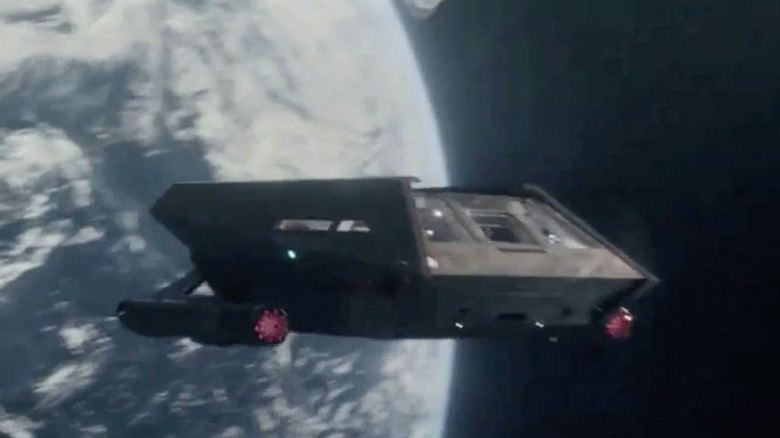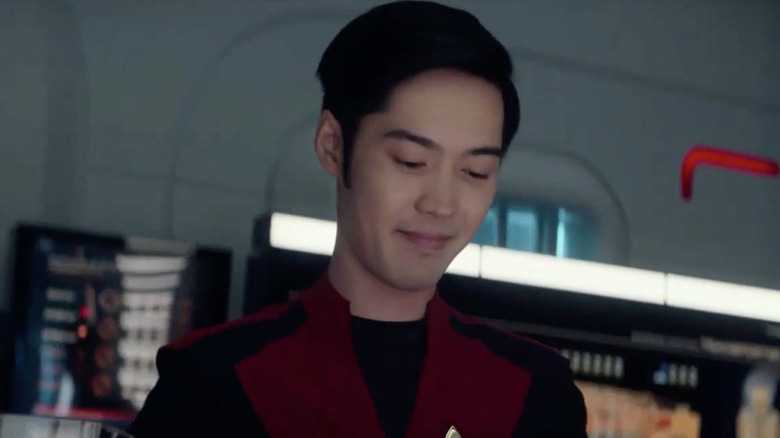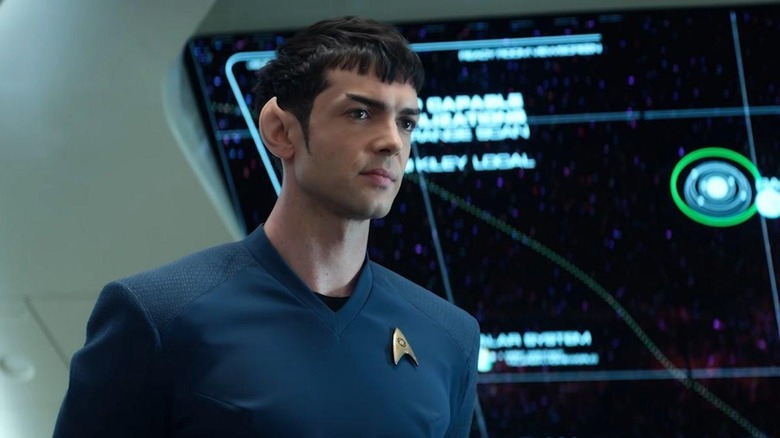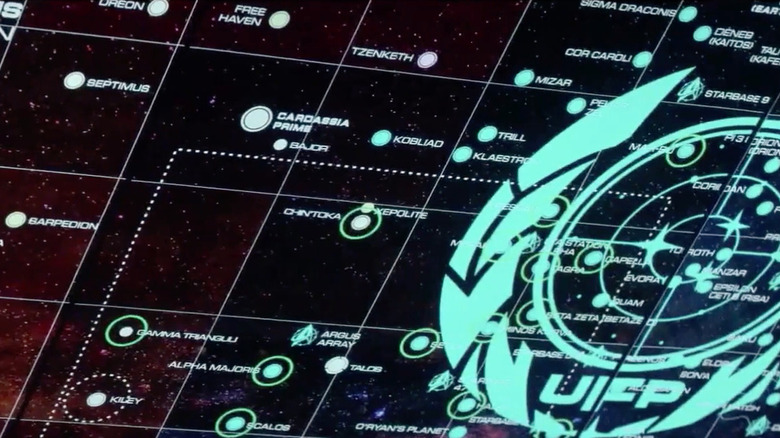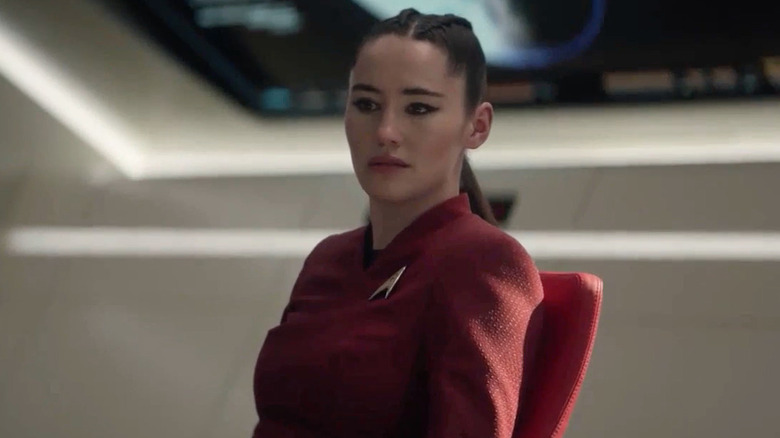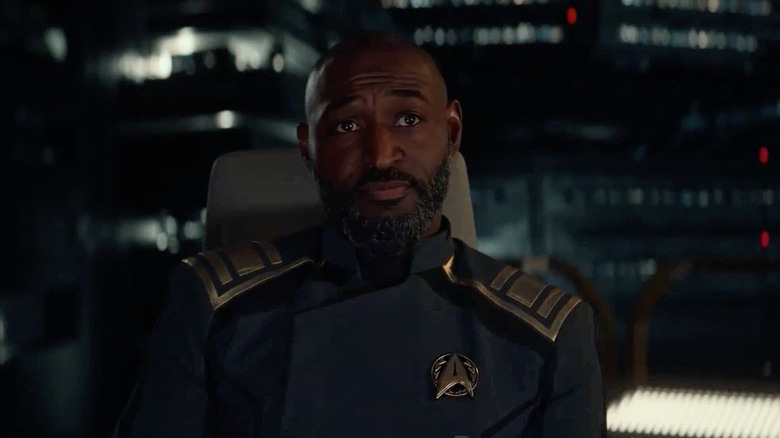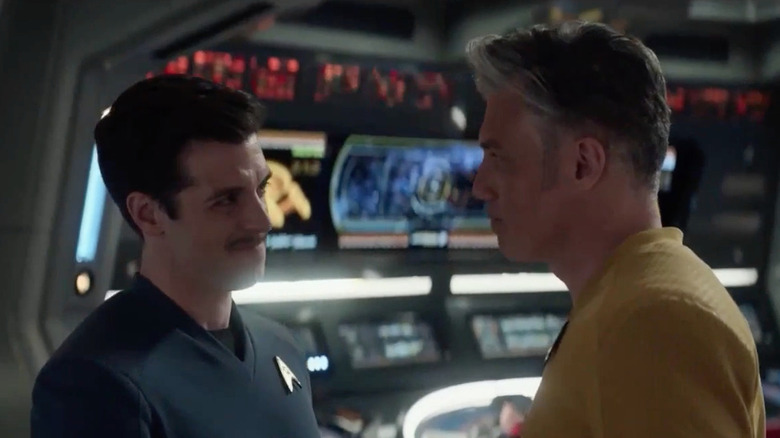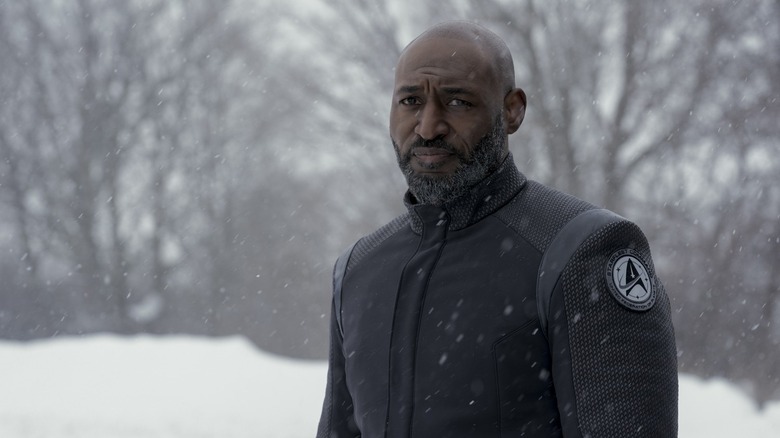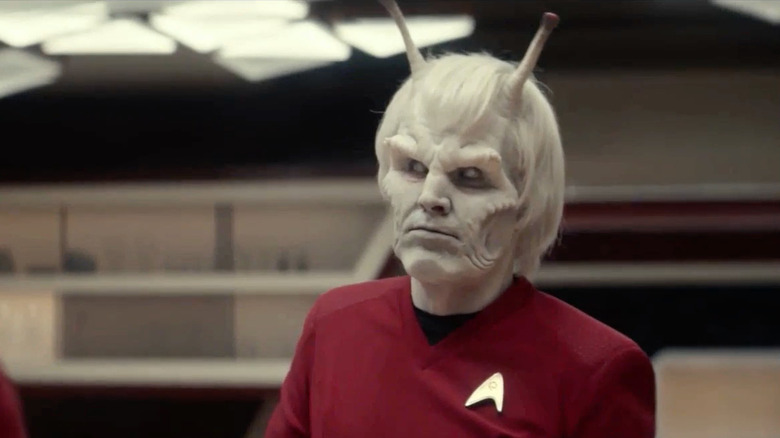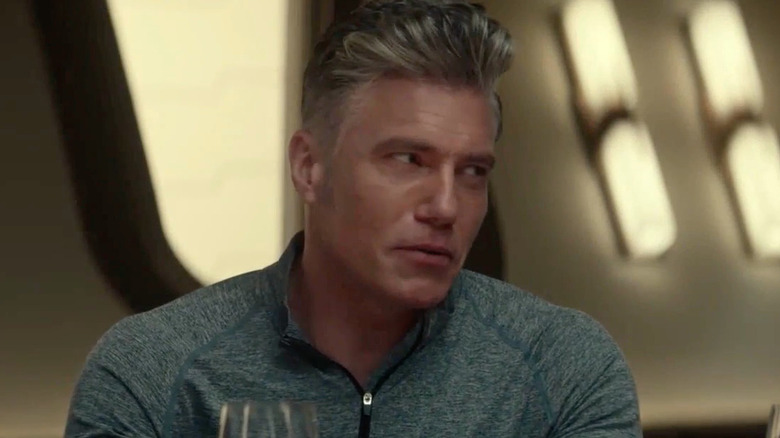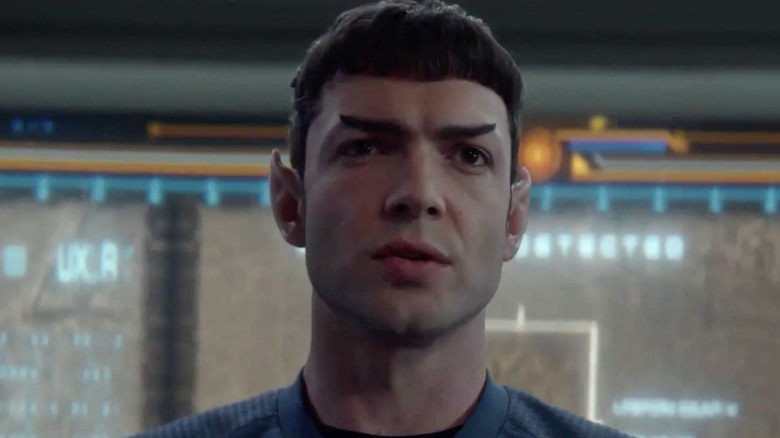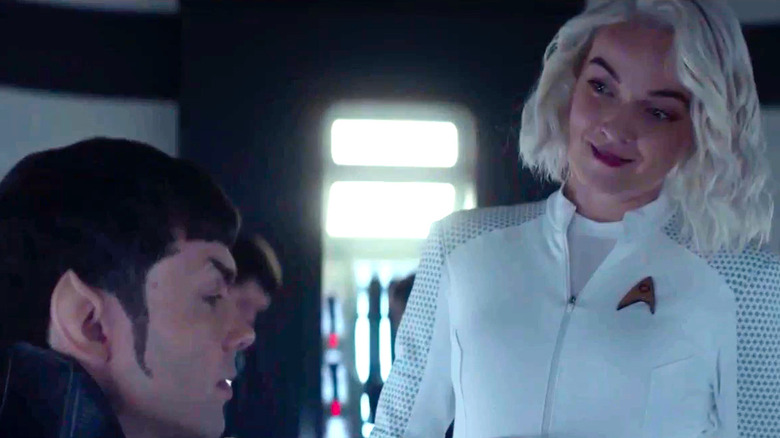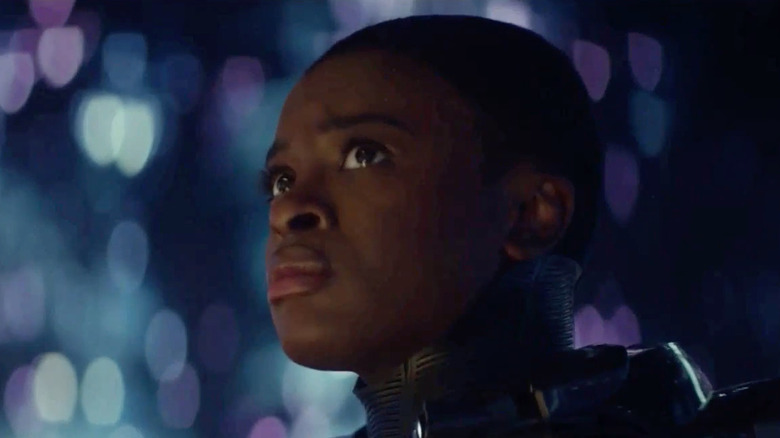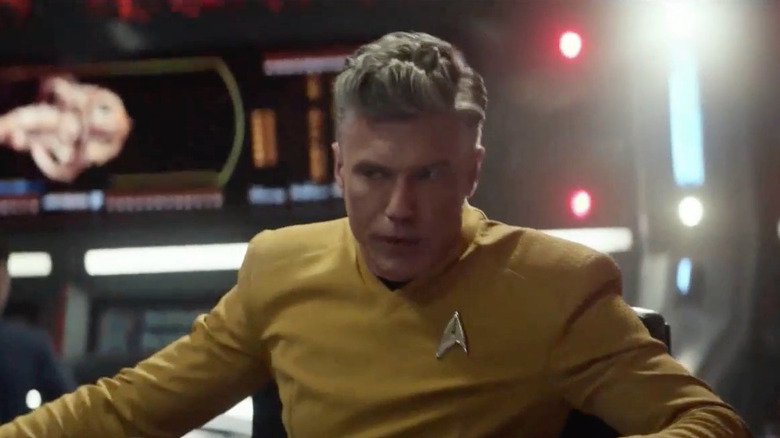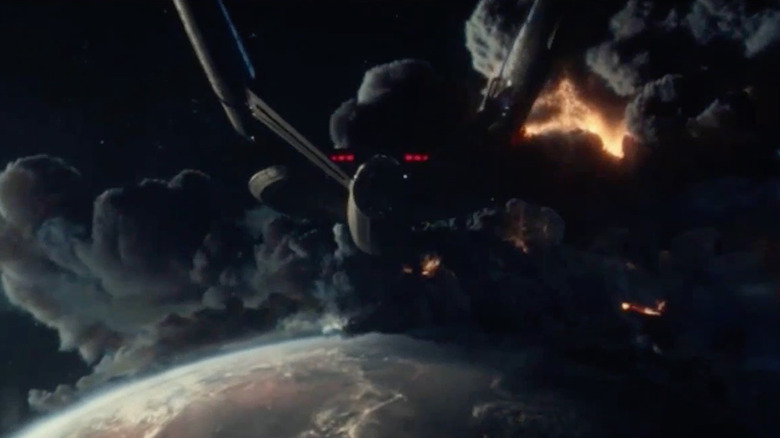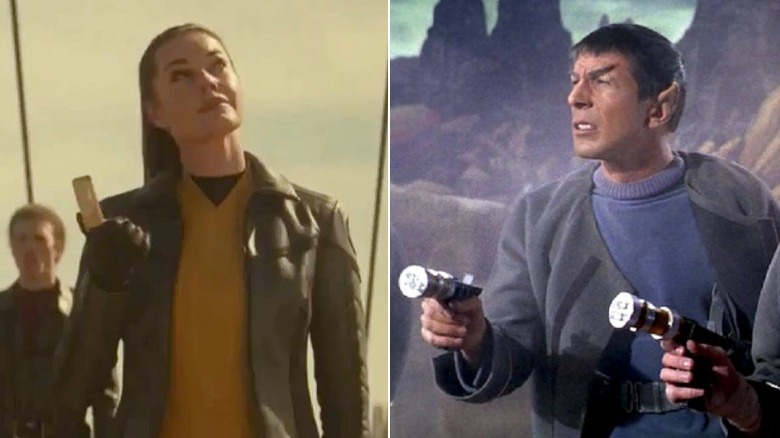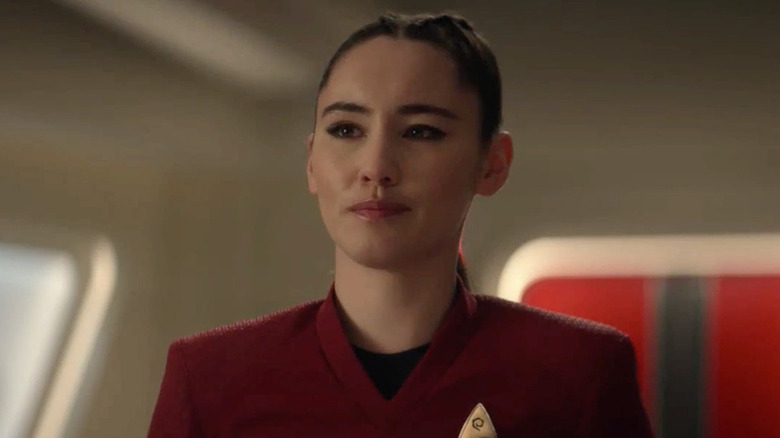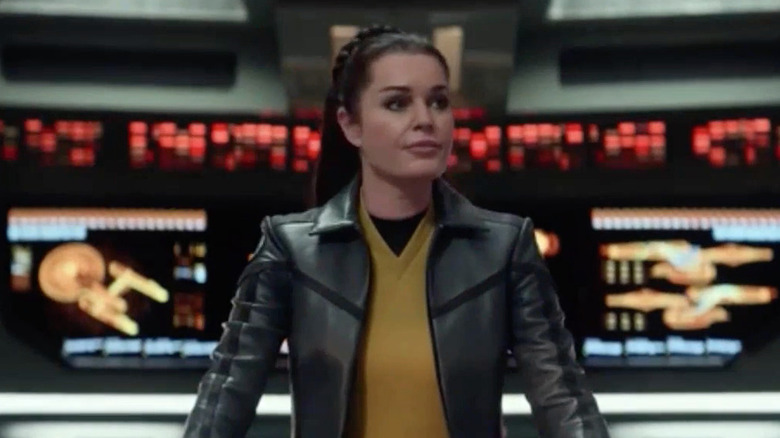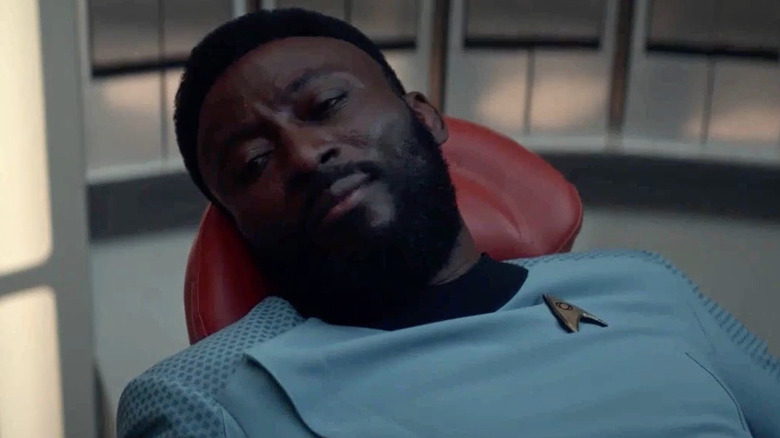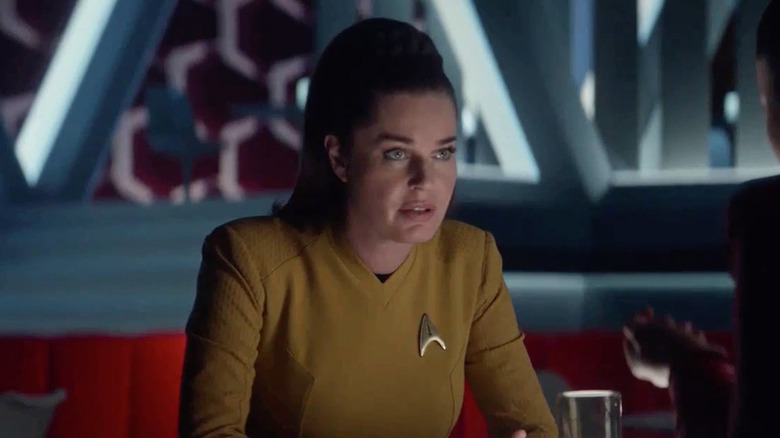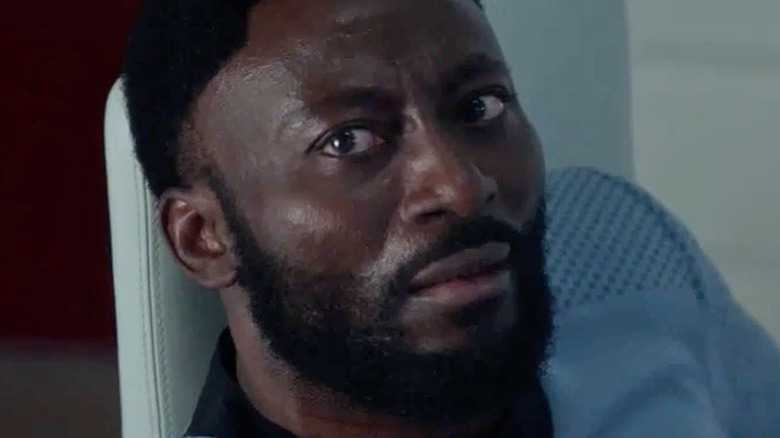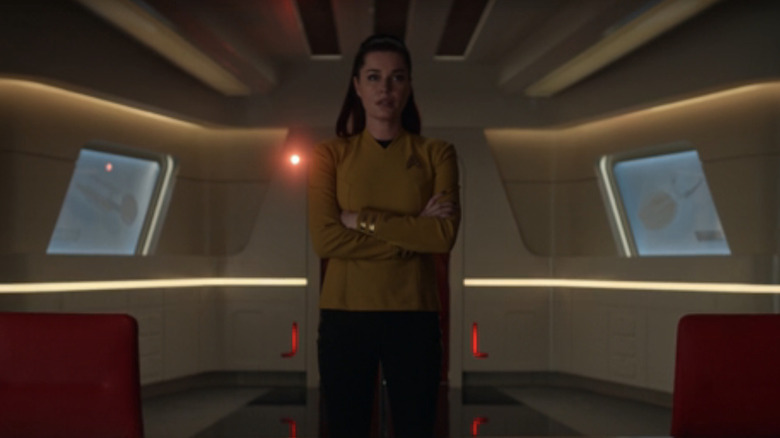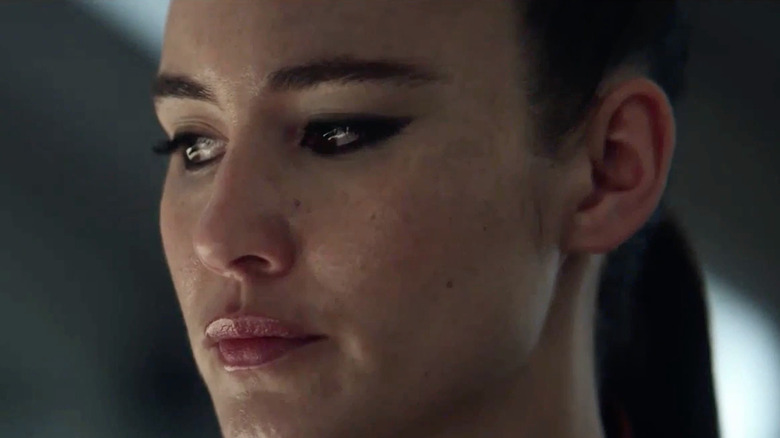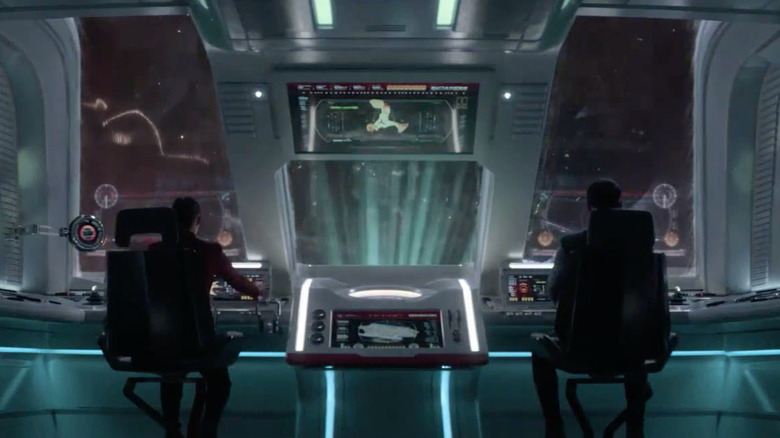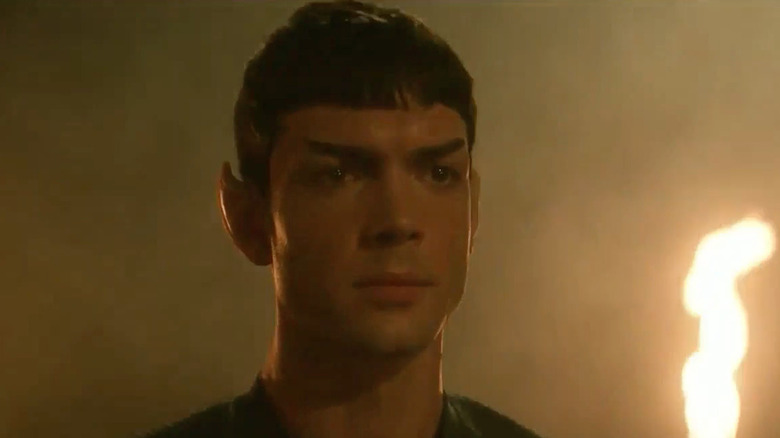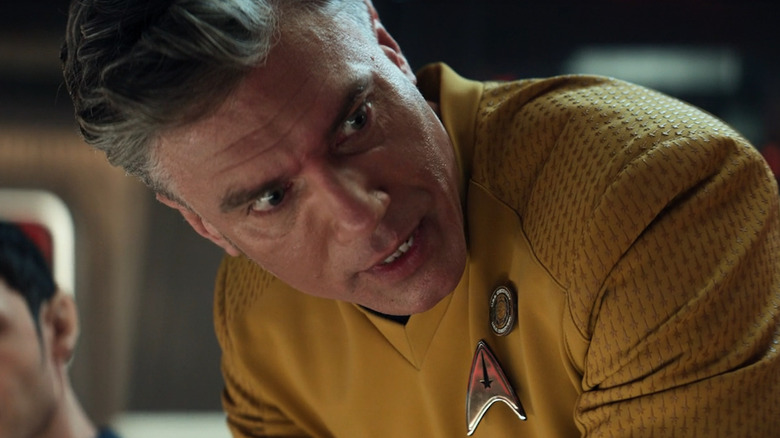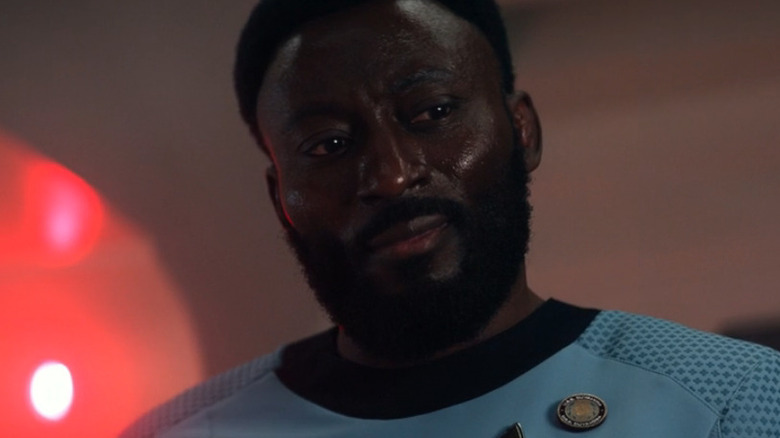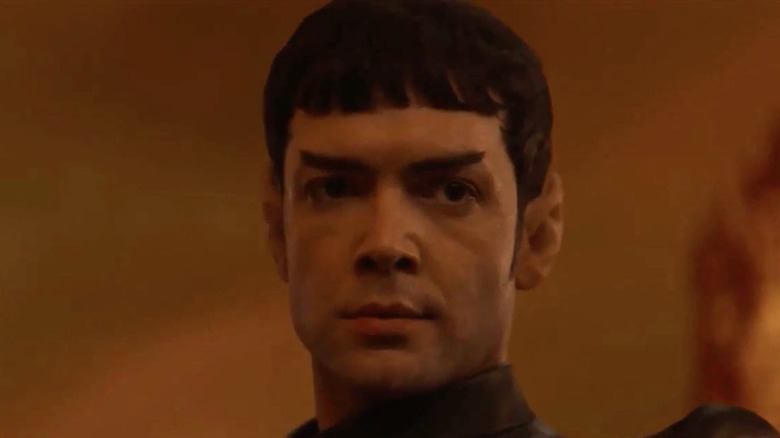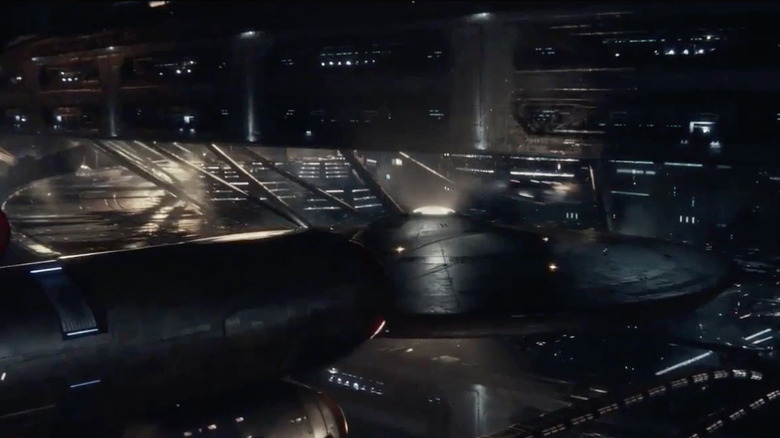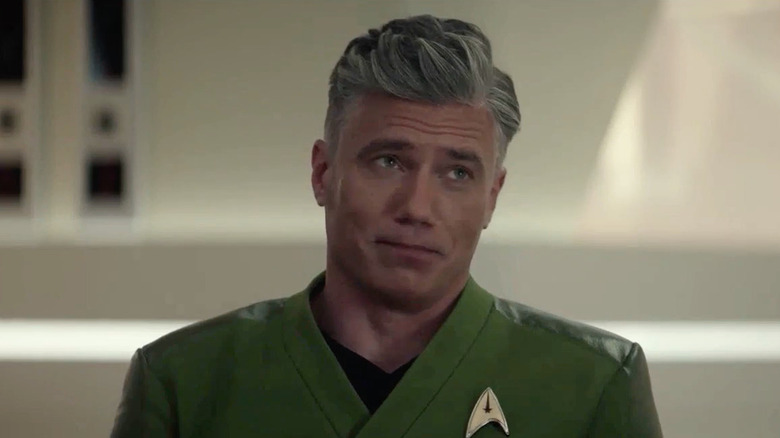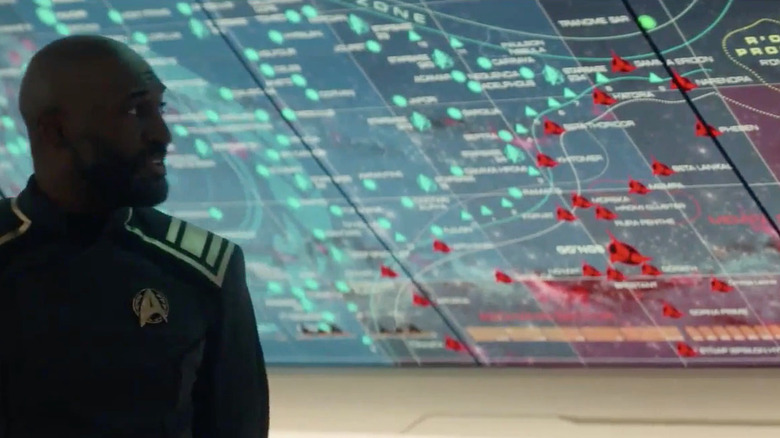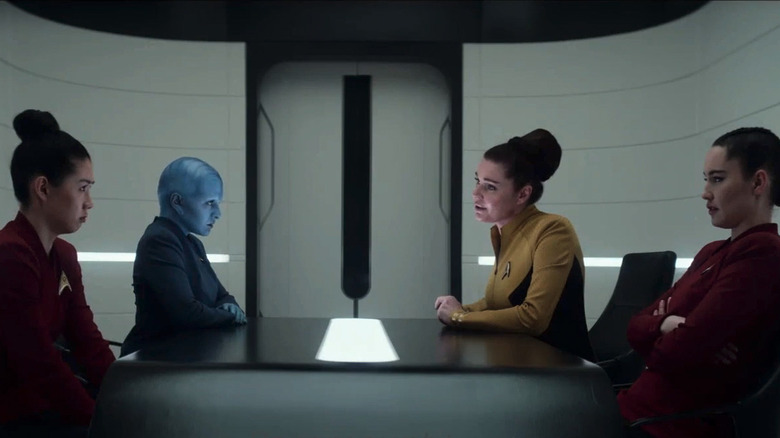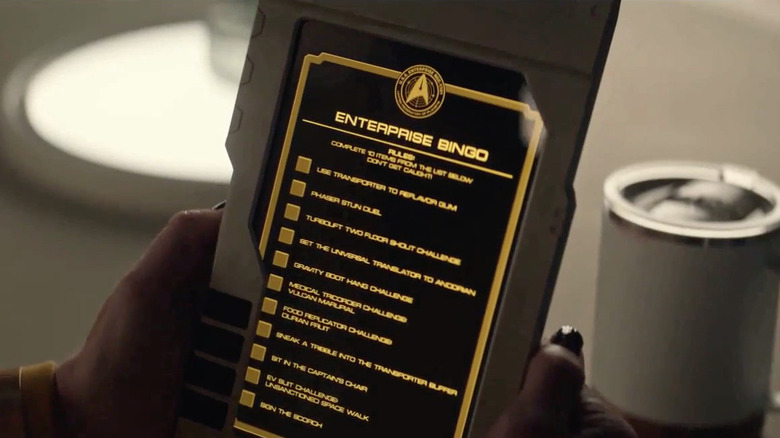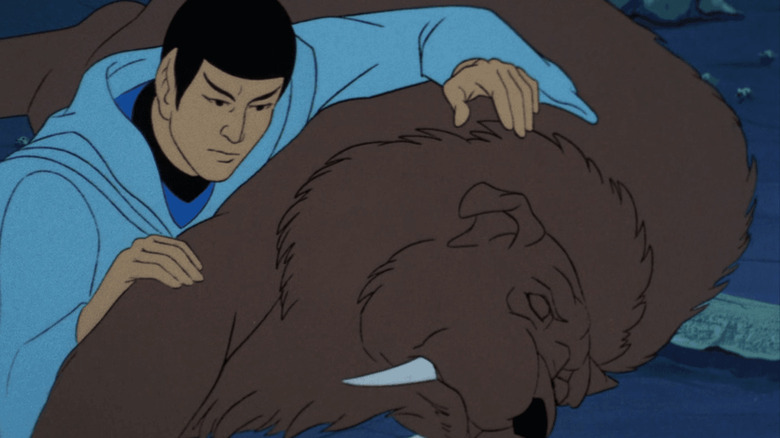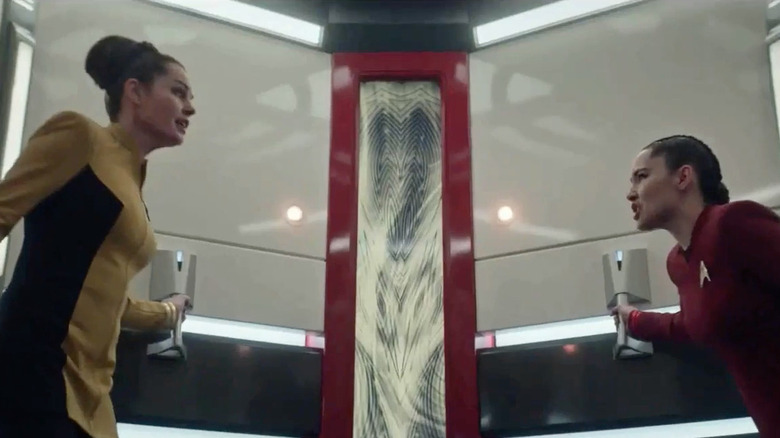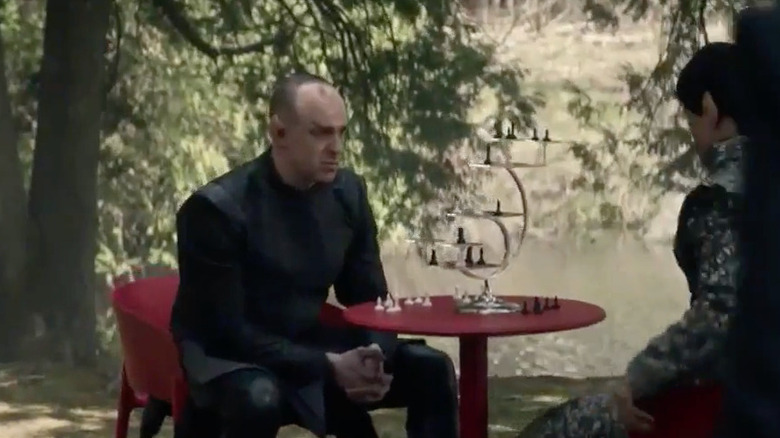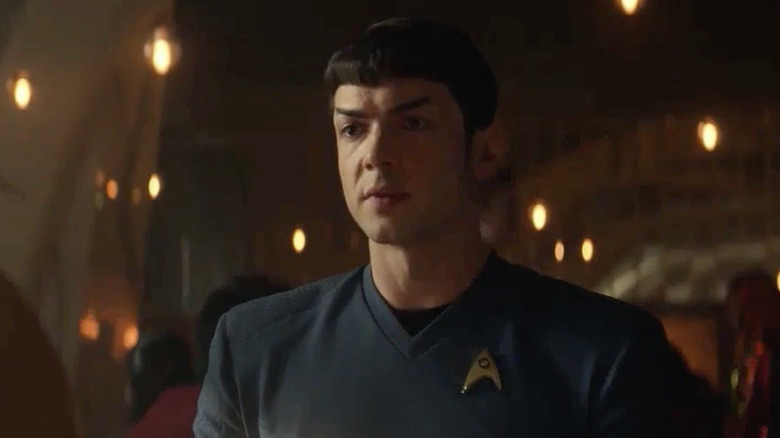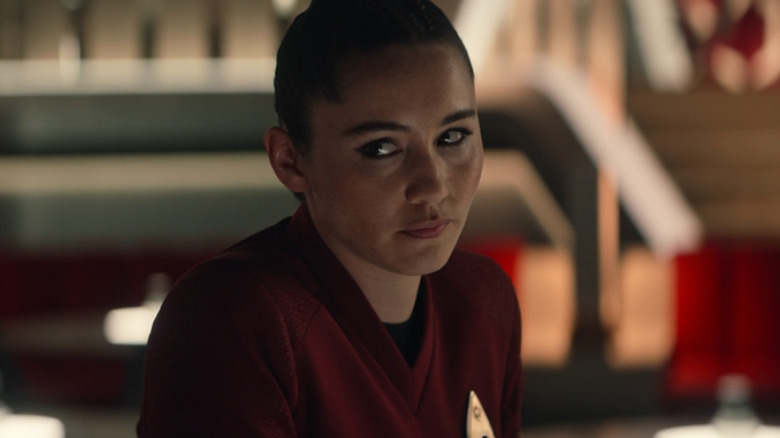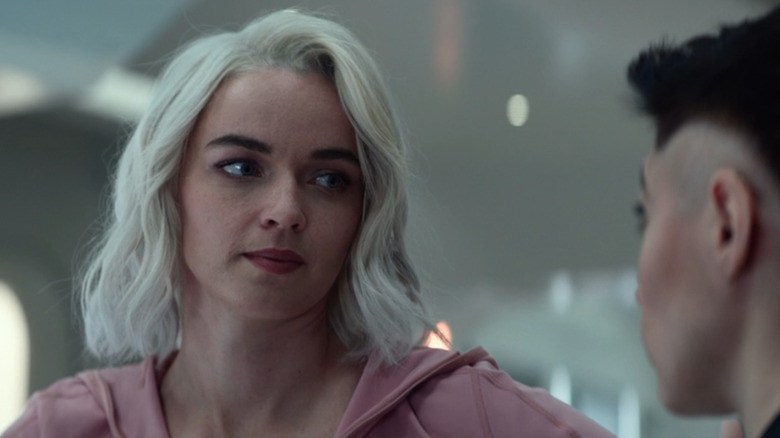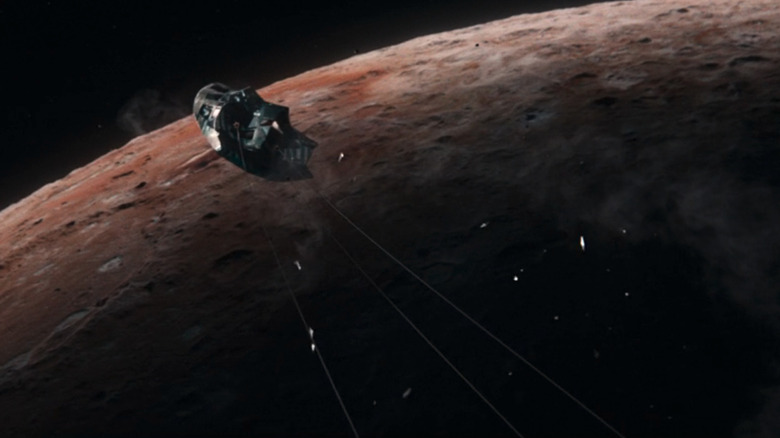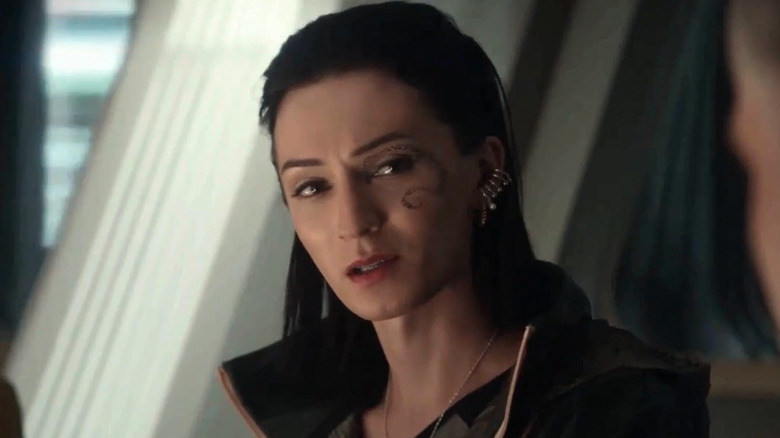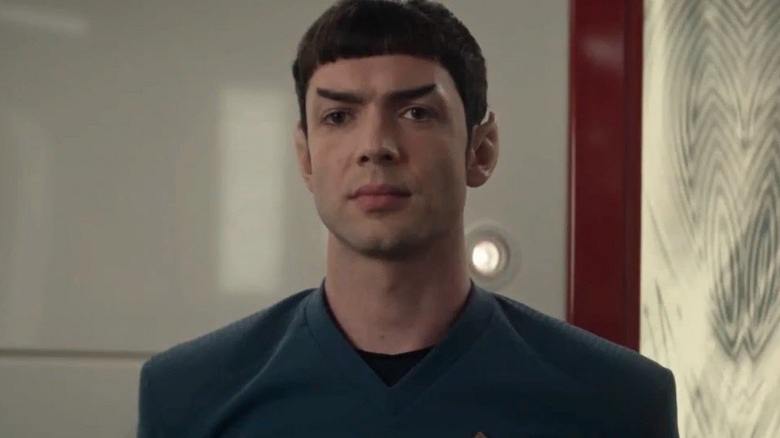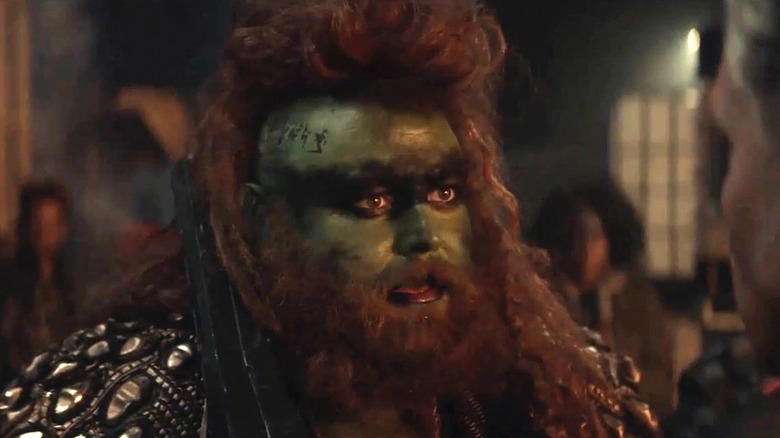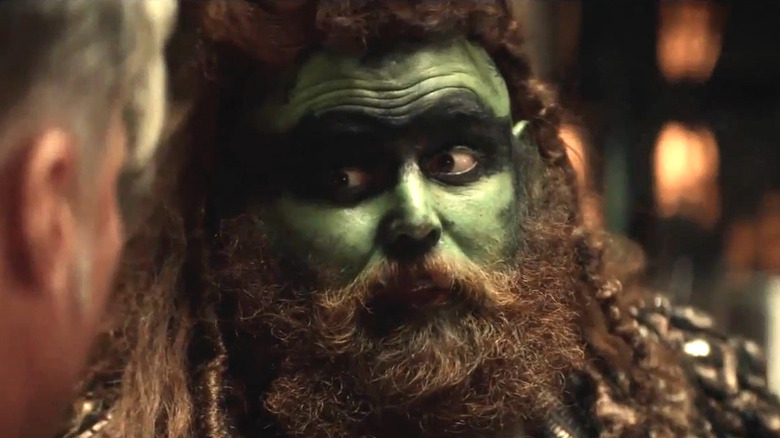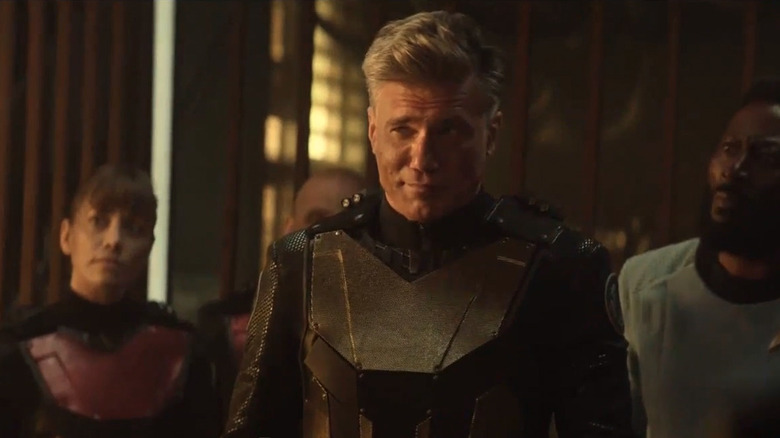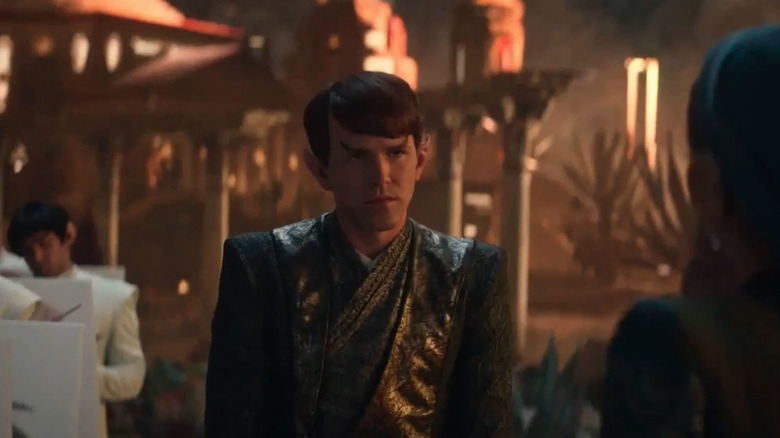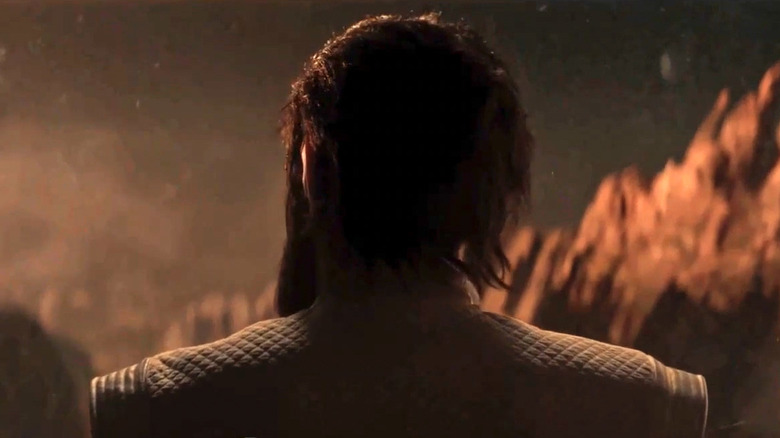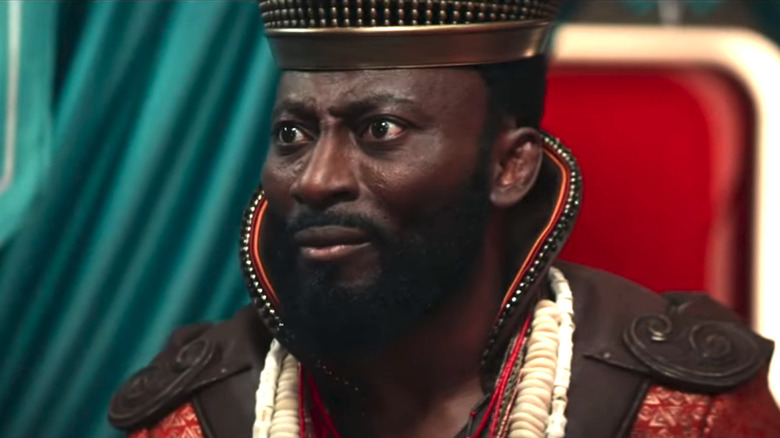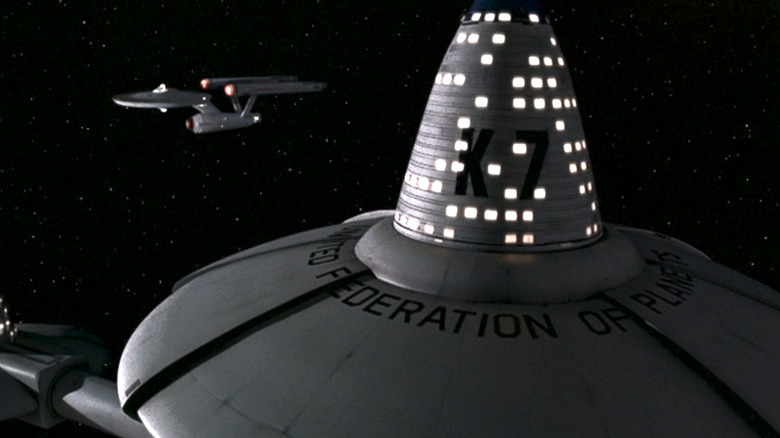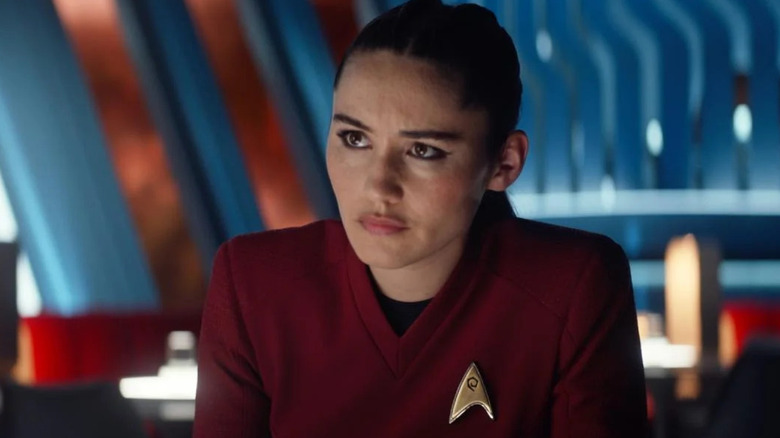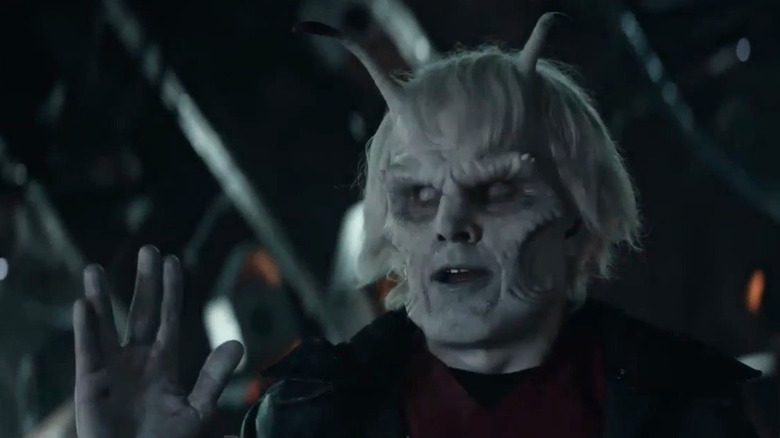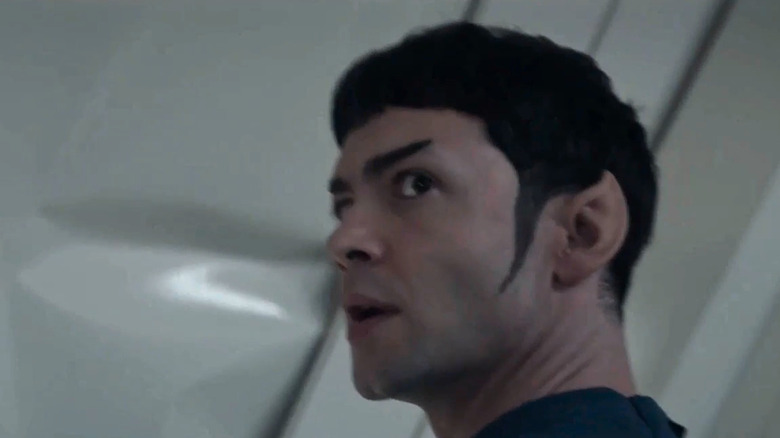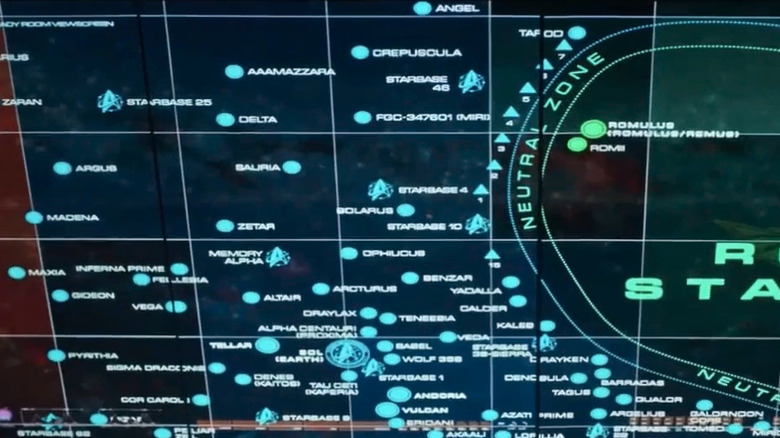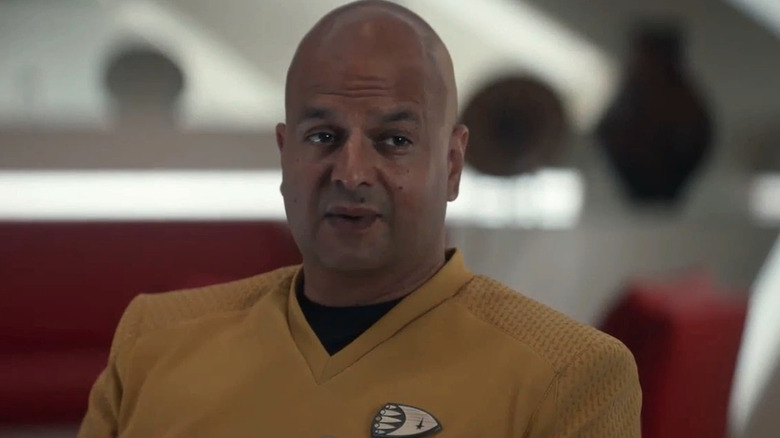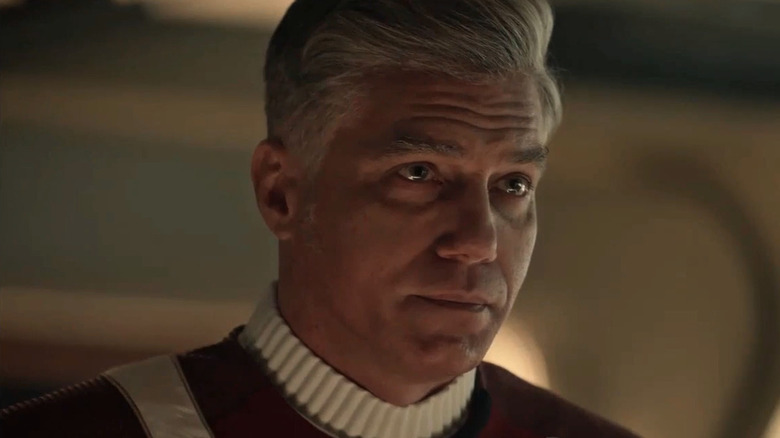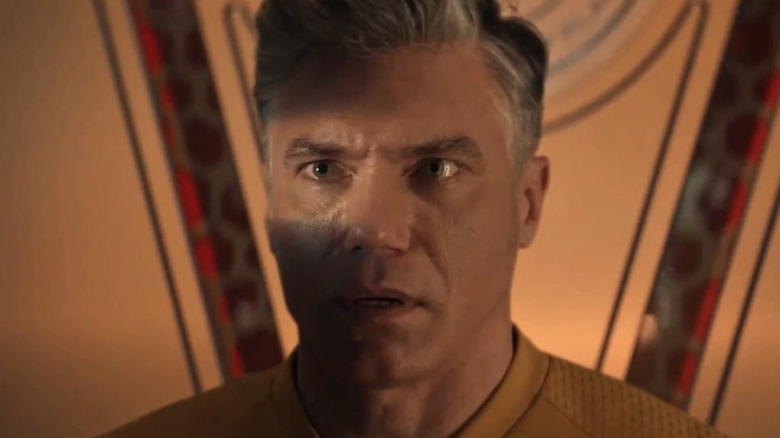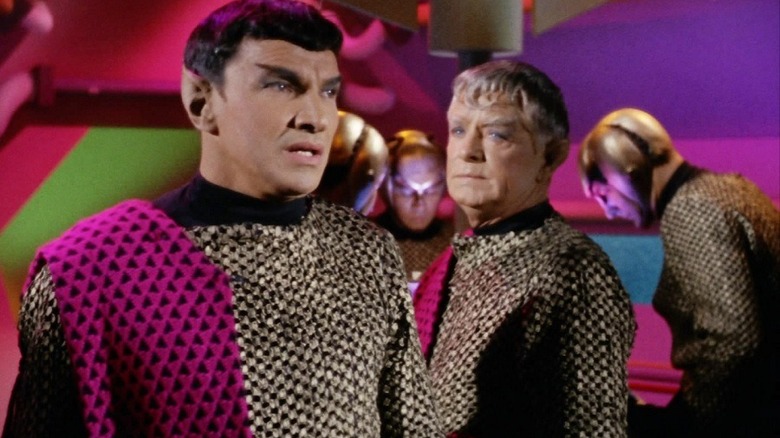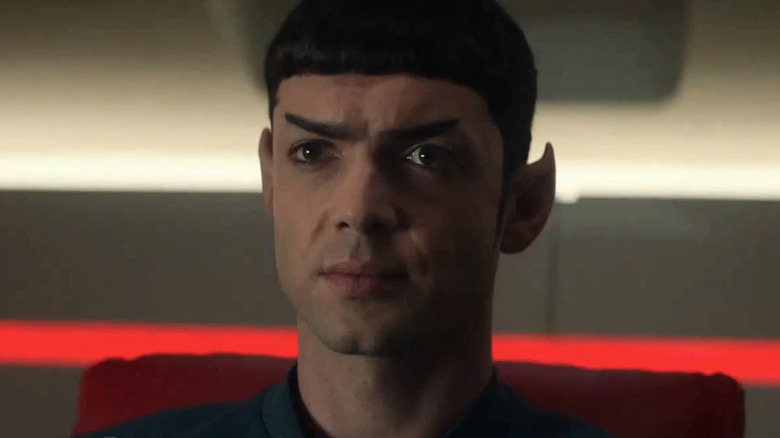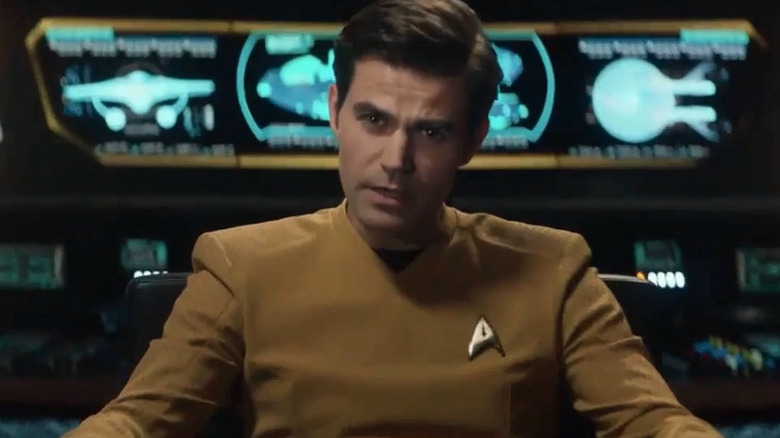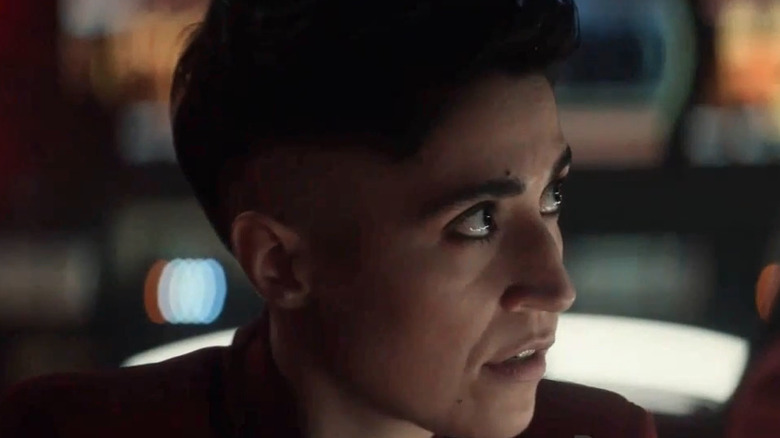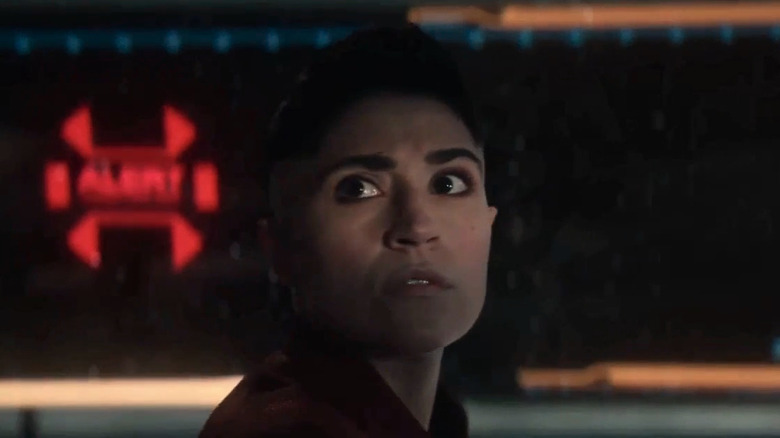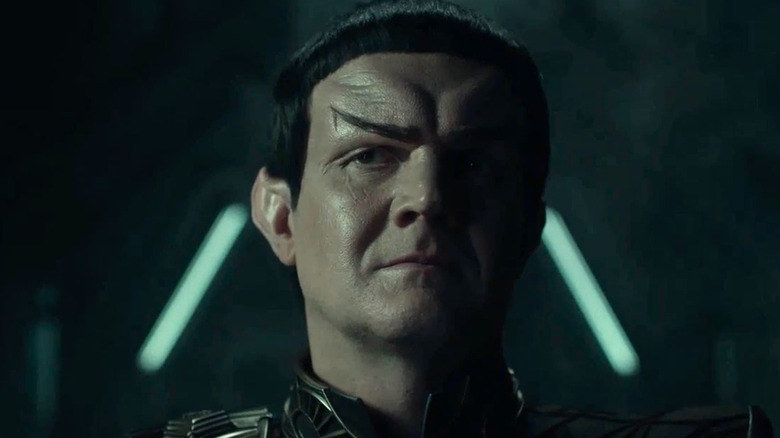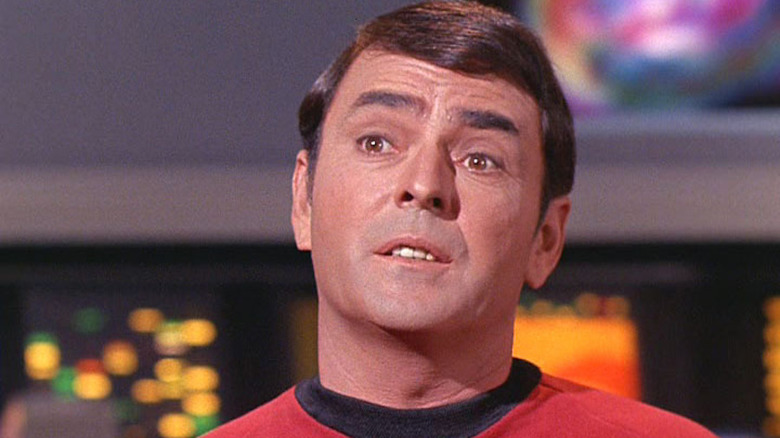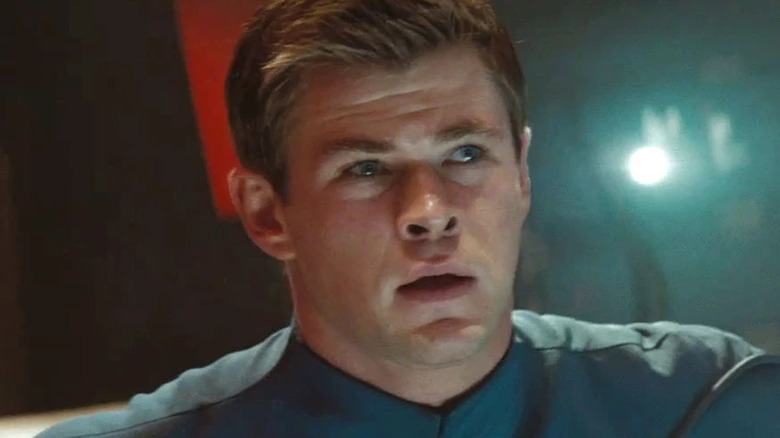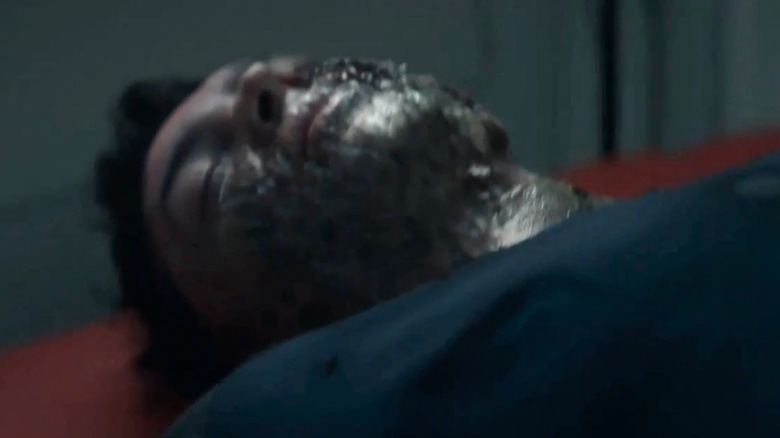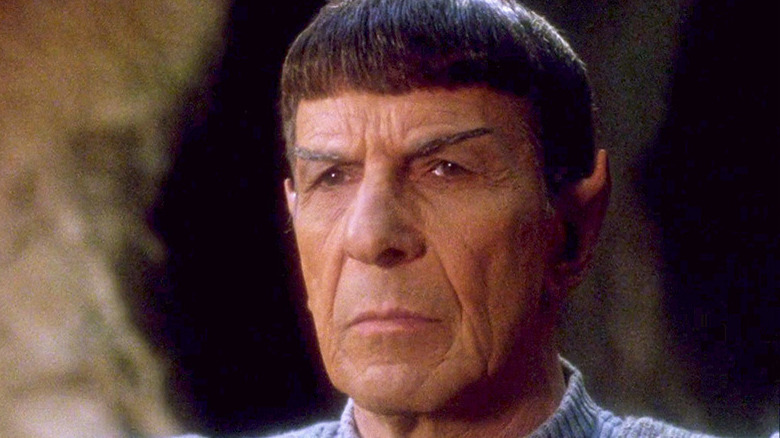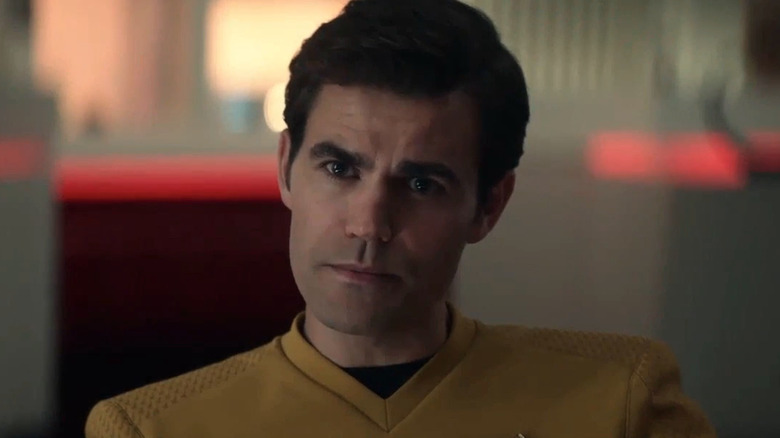Best Easter Eggs And References In Star Trek: Strange New Worlds
When Captain Pike, Spock, and Number One made their debut in the second season of "Star Trek: Discovery" aboard the original USS Enterprise, it wasn't long before fans were calling for the three classic characters to get their own spinoff series. Anson Mount, Ethan Peck, and Rebecca Romijn got rave reviews and continued their appearances in a pair of episodes of "Star Trek: Short Treks." As a result, it came as little surprise when "Star Trek: Strange New Worlds" was announced as the next original streaming series on Paramount+.
Set less than a decade before "Star Trek: The Original Series," "Strange New Worlds" is set on the same Enterprise and features many of the same characters. Though it ties into the original series pilot "The Cage" by featuring Captain Pike, there's still much we don't know about this era of "Star Trek," which provides a wealth of story possibilities for the ship and its crew. It also means there are plenty of opportunities for Easter eggs, references, and connections to the wider lore. The first episode alone, simply titled "Strange New Worlds," references just about every previous series, with allusions to characters and moments from every era of "Star Trek."
Already renewed for a second season, we're excited to see how the series takes the franchise up to the days of Captain Kirk. For now, though, we're watching every episode and are keeping our eyes peeled for all those Easter eggs, references, and connections. Scroll on to see the best ones we've found in Season 1 of "Strange New Worlds."
USS Archer
The premiere episode of "Star Trek: Strange New Worlds" opens with a dramatic scene on an alien world not unlike our own in the early 21st century, as scientists and military leaders make a startling discovery: an advanced starship has been spotted above the planet. We later learn that the ship traveled to this world under the command of Una Chin-Riley, Captain Pike's Number One, but it's the name of the starship that offers up our first Easter egg.
Designated the USS Archer, it's a clear reference to one of Starfleet's greatest captains and the star of the 2001 series "Enterprise." Played by Scott Bakula, Archer was captain of the NX-01 Enterprise before the founding of the Federation and helped shape the creation of the interplanetary organization. At the helm of Enterprise starting in 2150, Jonathan Archer made first contact with any number of alien worlds during his captaincy, many of which we saw on the four-season series. As such, it makes sense that a ship assigned to first contact missions would bear his name in the 23rd century.
It's also not the first USS Archer we've seen, as another ship with the same name was mentioned in the tenth feature film, "Star Trek: Nemesis," released just a year after "Enterprise" launched on television. Interestingly, the 23rd-century version's single nacelle set-up bears a resemblance to the USS Kelvin, the starship seen at the opening of the 2009 "Star Trek" reboot directed by J.J. Abrams.
Shuttle Stamets
Called back into service by Admiral "Bob," Christopher Pike finds himself in a Starfleet uniform once again and being ferried to a space dock where the Enterprise is waiting for him. He is taken by a young Starfleet officer aboard a shuttlecraft that bears a striking resemblance to the shuttles seen on "Star Trek: The Original Series," reimagined and redesigned for the new series. The name of that shuttle provides our next Easter egg. Calling station control, the officer announces her arrival aboard the Shuttle Stamets. It doesn't take a diehard Trekkie to know the shuttle is a reference to "Star Trek: Discovery" star Anthony Rapp and his character Paul Stamets, the Federation's leading astromycologist. But why would Starfleet canonize him by naming a shuttle after an active Starfleet scientist?
Well, because technically Stamets is no longer active in this era. At the conclusion of Season 2 of "Star Trek: Discovery," the USS Discovery must travel into the far future to save billions of lives from a galactic threat. Due to the nature of the threat, the mission was classified, and Starfleet considered the vessel lost with all hands. As far as anyone on "Star Trek: Strange New Worlds" is concerned, the entire crew is dead, including Stamets. It would seem that not long after the ship's "destruction," Starfleet commemorated the officer by naming one of Enterprise's shuttles after him. This is an appropriate honor, as it fits the Enterprise's theme of naming its shuttlecraft after famous scientists, with "Star Trek: The Original Series" featuring shuttles named for historic thinkers like Galileo and Einstein.
Chief Kyle
During the Enterprise's mission to Kiley 279, a landing party is assembled consisting of Captain Pike, acting first officer La'an Noonien Singh, and science officer Spock. In addition to feeling like a classic "Star Trek: The Original Series" away mission, they are beamed down by their transporter chief, who Pike refers to as Chief Kyle. He later plays a crucial role in the success of the mission, using an ingenious and inventive technique to beam down a serum into Spock's eyes to allow him to pass through a retinal scanner on the planet's surface.
Eagle-eared fans will recognize that Chief Kyle is not a new character created for this series but one whose origins date back to the original "Star Trek" series. Appearing in nearly a dozen episodes, the chief went unnamed for several stories until Spock addressed him as Kyle in "Who Mourns For Adonais?" He later appears in a small role in "Star Trek II: The Wrath Of Khan" and even pops up briefly in the 2009 big-budget reboot from J.J. Abrams. The original role was played by English actor John Winston, while the rebooted version was played by Chris Doohan, son of original Scotty actor James Doohan. Here, Chief Kyle is played by actor André Dae Kim. According to his IMDb profile, he will recur throughout the series, so perhaps we'll finally learn more about him.
Pike's attitude towards Vulcans
As the crew grapples with the dilemma of Kiley 279, Spock realizes the problem. It turns out that the people on the planet haven't developed warp drive — the first necessary step towards making them worthy of first contact — but instead developed a so-called warp bomb. In a briefing room, Spock discusses the problem with Captain Pike and acting first officer Noonien Singh. As he describes the normal process of first contact procedures, he notes that the Vulcans created the process, to which Pike responds with a proverbial eye roll, "as they never fail to remind us."
This attitude towards the Vulcans, and their perceived smug superiority, is a callback to "Enterprise," a prequel set nearly a hundred years before "Strange New Worlds." There we learned that ever since Vulcans made first contact with Earth in 2063 — as seen in the "Star Trek: The Next Generation" era film "Star Trek: First Contact" — they have been helping to guide Earth's progress towards a larger role in the interstellar community. However, many saw the Vulcans as a limiting force on humanity's progress. Some, including Captain Archer, saw the Vulcans as arrogant and overbearing.
In fact, Archer's mission on the Enterprise had been opposed by the Vulcans, who ultimately assigned their own officer, T'Pol, aboard the ship. Onboard, T'Pol often cited long-held Vulcan procedures, rules, and regulations, including those of first contact with pre-warp worlds, which Archer took under advisement, but often ignored.
Star chart name drops
As Spock briefs the captain he pulls up a star chart of the region, providing perhaps the episode's best Easter egg moment, worthy of a long pause. The star shart is filled with so many references to past episodes we could write an entire article on just this image alone.
Clearly visible are Cardassia Prime and Bajor, the two key worlds at the center of "Star Trek: Deep Space Nine." The chart is also littered with other familiar worlds, including Vulcan, Andoria, and Trill. The Klaestron system is not far from Trill, which makes sense as it was the home planet of one of Dax's former lovers. We also see Mizar, the system that was the home of Thol, and Cor Caroli, which is where Captain Picard cured a plague, both of which are featured in "Star Trek: The Next Generation." From "Star Trek: The Original Series," we see Sigma Draconis, Talos, Coridan, and Sherman's Planet. In addition, Azati Prime and Denobula, from "Enterprise," are depicted appropriately as not far from Earth.
Also from "Star Trek: Deep Space Nine" are worlds such as Tzenketh, Xepolite, Chin'Toka, Kobliad, Free Haven, and Dreon. We also see the Archanis sector marked in red in the lower right. The Klingons contested control of this region in Season 5 of that series, with Gowron calling their claim on the sector "ancient and indisputable." On the star chart, it is marked as Klingon territory.
Further "Star Trek: The Next Generation" callouts include Drayken, Tau Ceti — home of the mysterious traveler — and Nausicaa, which has produced some of the galaxy's most ruthless mercenaries. The Argus Array is listed as a Federation installation, which is featured in the episode "Parallels," where Cardassians are apparently tampering with it.
The Gorn
Back aboard the Enterprise after their away mission to Kiley 279, Pike, Spock, and Noonien Singh speak again in a briefing room. There, they discuss how to proceed with a pre-warp culture that is attempting to use advanced technology — copied from scans of a Federation starship — as a weapon. At this moment, we learn about Noonien Singh's past and the traumatic childhood incident that shaped her into the woman she has become. As we saw earlier on a PADD, the incident involved the Gorn, a species we've seen in live-action "Star Trek" only twice before.
In the classic "Star Trek: The Original Series" episode "Arena," Starfleet makes first contact with the Gorn, who have attacked a Federation colony on Cestus III. The Enterprise's captain, James Kirk, finds himself in a life-or-death battle with a Gorn soldier in one of that series' most iconic moments. Years later, on "Enterprise," we'd see the Gorn again, though this time it would be in the Mirror Universe, where a Gorn slave master named Slar is in charge of prisoners held aboard a futuristic starship from a parallel reality, the Defiant.
The premiere of "Star Trek: Strange New Worlds" explains that the Gorn have nurseries and keep human captives as food and breeding sacks, adding a gruesome new background to the lizard-like alien race. As the Gorn figure into La'An's backstory heavily, it's possible we might finally see them again in later episodes of "Star Trek: Strange New Worlds."
Changing General Order 1
The first episode of "Strange New Worlds" is appropriately centered on a first contact mission to a world we've never seen before, Kiley 279. In the best "Star Trek" tradition, the story revolved around a classic dilemma of whether or not to get involved in the affairs of a more primitive culture and society that has not yet achieved interstellar travel, potentially violating the Prime Directive. Though discussed heavily in the episode, some fans may find it curious that Pike and his crew refer to the directive however as "General Order 1." That's because in the original "Star Trek," it is called just that until about midway through the series when writers reshape the lexicon.
In "Star Trek: Discovery," and in this episode, it is called "General Order 1," in keeping with canon. However, the Starfleet Admiral that meets with Pike, Spock, and Number One at the conclusion of the episode notes that the order might need a new name. Thanks to Pike's reckless disregard of Order 1, he says, "[Starfleet] is doubling down, renaming it 'the Prime Directive.'" Pike rolls his eyes and responds, "well, that'll never stick." This is both an in-universe explanation for the back-and-forth naming of Starfleet's highest order in "Star Trek: The Original Series" and a meta-reference to the inconsistencies throughout early "Star Trek" history.
Lieutenant Kirk
Early in the premiere episode of "Star Trek: Strange New Worlds," we're teased with a surprising name drop when Captain Pike mentions a Starfleet officer named Lieutenant Kirk. It's an eye-popping moment: could the future Enterprise captain appear in the first episode? With Pike re-assembling his staff and personally selecting several new officers for the latest crew rotation, it seems he's asked for Kirk specifically, as Spock notes while they walk through the Enterprise's corridors. Nearer to the end of the episode, First Officer Una Chin-Riley tells Pike that Lieutenant Kirk has finally arrived on the Enterprise and is on his way to the bridge as requested. But when the officer walks through the doorway, we see it is not a yellow-shirted James T. Kirk but a blue-shirted science officer — with a surprisingly thick mustache.
Pike greets the lieutenant, shaking his hand and addressing him as Samuel Kirk. However, this is more than just a clever gag to bait-and-switch the audience, as Samuel Kirk is a character briefly seen in an episode of "Star Trek" in 1967 titled "Operation — Annihilate!" In the episode, deadly parasites attack an Earth colony on Deneva, causing mass insanity and taking many lives, including that of Captain Kirk's brother, Sam. We never see the brother of James Kirk in action, but we do get a look at his body after his death, and he's played by none other than William Shatner — who is sporting a thick Hollywood mustache. Thanks to Variety, we already know that James Kirk himself is set to appear in Season 2, so it will be interesting to see if his brother Sam figures into any future stories.
Admiral Robert April makes his live-action debut
Since the earliest days of "Star Trek" we've known that Captain Kirk was not the first captain of the Enterprise. Later on it was revealed that Christopher Pike was not even the first man to sit in the captain's chair. The honor of first captain of the Enterprise instead belongs to the fabled Captain Robert April, who has never before been seen in live-action. The closest fans had gotten to a glimpse of the former captain was in an episode of "Star Trek: The Animated Series." He appeared as an older man with the rank of Commodore, visiting the ship and reverse aging along with the rest of the crew in the episode "The Counter-Clock Incident."
In the premiere of "Strange New Worlds" we finally got to meet Robert April — now an Admiral — for the first time in live-action. Played by actor Adrian Holmes, he arrives by shuttlecraft at Pike's remote Montana ranch after the Enterprise captain had refused to answer his communicator. Pike even refers to Admiral April as "Bob," showing the close friendship between the two. This makes sense considering Pike's service record states that he was April's first officer aboard the Enterprise before his promotion to captain.
Though he only gets a single scene in the opening episode, it seems like Admiral Robert April — one of Starfleet's most decorated captains — could be set to become an ongoing recurring character in "Strange New Worlds."
Hemmer's origins are a major callback to Trek lore
The series' second episode "Children of the Comet" begins with a log entry from Cadet Uhura, the younger version of the future Enterprise senior officer played by Nichelle Nichols. She is still getting used to life aboard the Enterprise and is about to attend a dinner in the Captain's quarters. There she meets the ship's new chief engineer, an Andorian named Hemmer. But Hemmer is no ordinary Andorian — the normally blue-skinned, antennaed aliens who debuted in "The Original Series" episode "Journey to Babel." Hemmer is a subspecies of Andorian known as Aenar, who live in the frozen wastelands on Andoria, as seen in the "Enterprise" fourth season episode appropriately titled, "The Aenar." In the 22nd century there were only a few thousand of them on the planet.
When Uhura spots Hemmer chopping vegetables she offers to assist, knowing he is visually impaired, as Aenar are all blind. But Hemmer is quick to point out that while he may be unable to see, his people are no less able — with his other senses not just compensating but making him superior to ordinary humans — and needs no help. It's also mentioned that Aenar have a form of precognition, and Spock demonstrates Hemmer's telepathic powers as well. Both of these unique abilities were showcased in the "Enterprise" three-part story that introduced a young Aenar woman named Jhamel and her brother Gareb, who until now were the only Aenar ever seen on "Star Trek." In that story, the Romulans kidnapped Gareb and used his abilities to power a deadly new drone ship in an attempt to provoke a war between galactic powers.
Nausicaans seem to like hassling future Enterprise captains
During his dinner with the crew, Captain Pike entertains his people with a story from his earlier years. He was chasing down a Nausicaan while working a security job and fell flat on his face after tripping over, phaser still in hand. It's an incident that would apparently play at least some role in his switch to command, but it wasn't the last time a future Enterprise captain would tangle with some nasty Nausicaans. While we haven't seen Nausicaans that often, this brutish alien race made a memorable first impression in the "Next Generation" episode "Tapestry."
In that story, Picard dies and meets Q in the afterlife. He offers him a chance to go back in time and change his past. In doing so, Picard revisits a violent incident from his early days in Starfleet. While awaiting his first orders after graduating Starfleet Academy, Picard and two friends have a run-in with some Nausicaans who attempt to cheat them in a game of dom-jot. Defending his friend from a vicious melee, Picard got impaled through the back by one of the aliens, requiring him to have an artificial heart implanted that he'd carry for the rest of his natural life. Thankfully, it doesn't sound like Pike's brush with Nausicaans was quite so harrowing.
A return to a TNG star system
The episode "Children of the Comet" takes the Enterprise to the Persephone star system. A planet there is endangered by a massive comet which is due to strike its surface in a world-ending event that will leave no survivors. In his briefing, Spock says that the people on the planet are a primitive race with no way to know the threat they are facing, and no way to stop it even if they could see it coming. With the people below unable to save themselves, Pike and the crew get to work on finding a way to divert the comet from Persephone III. But this won't be the last time an Enterprise crew makes a visit to Persephone, as we have seen this planetary system before. It originally popped up in a first season episode of "Star Trek: The Next Generation," set nearly a century later.
Though it wasn't Persephone III, the Enterprise D visited the Persephone system in the episode "Too Short a Season." In that story, Picard and his Enterprise crew travel to Persephone V to pick up a renowned Federation negotiator (the elderly Admiral Mark Jameson) who has been called in to see to the release of prisoners taken in a terrorist hostage crisis. Things don't go as planned, of course: It's revealed that Jameson himself may be responsible for the crisis, the fallout from another incident he was involved in decades before.
Chapel's budding love for Spock
Nurse Christine Chapel and Mr. Spock had a brief interaction in the premiere episode, and their encounter in "Children of the Comet" made it clear there's some serious tension there — at least from Chapel's side of things. As Spock, La'An, Uhura, and Lt. Kirk (not James) prepare to beam to the surface of the comet, Chapel inoculates them with an anti-radiation drug. When she administers a dose to Spock, she openly flirts with the Vulcan science officer, though Spock doesn't seem to notice. Uhura does, however, and mocks him later in the episode, sarcastically referring to Chapel as his girlfriend.
The sparks are, of course, a direct reference to "The Original Series," in which Nurse Chapel (played then by series creator Gene Roddenberry's wife Majel Barrett) showed an open attraction to Spock (Leonard Nimoy) and even got jealous of his relationship with T'Pring. It was in the episode "The Naked Time" that Chapel professed her love for him, and in "Plato's Stepchildren" they even shared a kiss, though it was while they were coerced by alien telepaths, and neither was entirely comfortable with the encounter. Under the influence of a love potion, Spock himself became infatuated with Chapel in the quasi-canonical "Star Trek: The Animated Series" episode "Mudd's Passion." Where "Strange New Worlds" will take their relationship remains to be seen.
Uhura is already a good singer
Once arriving on the comet's surface and heading into the alien structure they find there, the landing party discovers a mysterious alien egg. Unable to get many readings, it's up to Uhura to decipher the inscriptions on the egg's surface and find a way to communicate with the intelligence at work in the hopes of lowering the comet's artificial shielding. If she can't, the comet may be destined to destroy Persephone III. But it's Uhura's first away mission, and the first time she's ever been responsible for something this critical. Luckily, Uhura unwittingly discovers how to communicate with the egg when she absent-mindedly begins humming an old Kenyan folk melody.
As it turns out, the comet's intelligence communicates through musical tones. It's lucky that Uhura was on the away mission rotation, because she's well known to be a talented singer. Diehard Trekkies will recall that in "The Original Series," Uhura had shown an aptitude for singing, and was seen doing so on more than one occasion. She was most fond of a song called "Beyond Antares," which she sang in two different episodes, "The Conscience of the King" and "The Changeling." They were performed by actress Nichelle Nichols herself.
Later in "Children of the Comet," Uhura and Spock sing together to communicate with the intelligence, and, as "Star Trek" fans know, this wouldn't be the last time they perform side by side. In the 1966 episode "Charlie X," Spock plays a Vulcan lute while Uhura accompanies him with her sweet voice, performing a song titled "Oh, On the Starship Enterprise."
An escape inspired by a former captain
As the landing party works inside the comet to alter its course in "Children of the Comet," Pike and the Enterprise find themselves confronted by an alien ship. The beings aboard it refer to themselves as "The Shepherds." They warn Pike not to interfere with the comet, which they believe is a kind of divine life-bringer. This is a powerful starship that the Enterprise can't quite compete with, so they're careful not to anger them, but they cannot abandon the mission to save the planet either. When they're finally forced into a firefight, Pike issues a command to get them out of there, barking "Escape pattern April Omega Three!"
This is a clear reference to Robert April, the former Enterprise captain who we met in the "Strange New Worlds" premiere. April became official canon in an episode of "Star Trek: Discovery," where his name appeared on a computer screen as part of a list of Starfleet's most decorated captains, alongside Pike, Jonathan Archer (from "Star Trek: Enterprise"), Matthew Decker (from "The Original Series" episode "The Doomsday Machine") and Philippa Georgiou of "Star Trek: Discovery." With April having his own escape maneuver named after him, it's no wonder he's considered one of the best.
A visit to an Illyrian colony
In the third episode, "Ghosts of Illyria," the Enterprise visits an Illyrian colony on an alien world. According to Number One's log entry, which opens the episode, the colony has been abandoned with no explanation, and they are there to discover why. She also describes Illyrians as a race of people who use genetic modifications to "enhance their capabilities and levels of function." But the Illyrians are not a new species to "Star Trek," having appeared once before in a third season episode of "Enterprise" titled "Damage."
That episode took place in the midst of the season's Xindi War arc and saw Captain Archer encounter an Illyrian vessel while his ship was badly damaged. The Illyrians were also in distress, so Archer offered to help, but he wanted a warp coil in return. The Enterprise's warp drive had been rendered non-functional, and without a new one they would be unable to stop the Xindi from completing their mission to wipe out Earth. Denied by the Illyrians (who can't afford to go without a warp drive either), the story sees Archer grapple with the moral decision of whether or not to steal it in order to save billions of lives.
In "Ghosts of Illyria," the one Illyrian we do see is identical to a human, while the Illyrians in "Damage" had a series of unusual cranial ridges. Of course, given their practice of genetic modifications, it's anyone's guess what Illyrians look like naturally.
The landing party uniforms pay homage to The Cage
In Episode 3, a landing party is sent to the Illyrian colony to investigate. We see Pike, Una, Spock, and a handful of Enterprise officers looking for anything that might point to why the colony was abandoned. Our first clue is the massive electrical storm on the horizon. The away team is dressed for the occasion, sporting dark gray duty jackets over their more colorful classic uniforms. It's a cool look, but it's also an Easter egg — we saw something similar in "Star Trek: The Original Series." The gray landing party jackets appear to be a nod to the overcoats worn by the away team in "The Cage," the original pilot episode.
In "The Cage," Pike, Spock, and the rest of the landing party sport similar coats during their away mission to a planet in the Talos system, which has been broadcasting a distress signal. The rejected pilot episode wasn't seen in full until it was released on VHS as part of the 20th anniversary celebrations in 1986, though footage from it did appear in "The Original Series" episode "The Menagerie," which flashed back to the events on Talos IV. The jackets seen in "Ghosts of Illyria" are a clear callback, with the design updated for the new series, offering crew members better protection in hostile environments.
La'an has a big bad in her family tree
When the names of the Enterprise's crew on "Strange New Worlds" were revealed to the public, fans immediately suspected a big backstory reveal for the ship's chief of security. The character, La'an Noonien Singh, shares a well-known last name with one of the biggest baddies in "Star Trek" history, Khan Noonien Singh. Best known as the nemesis of Captain Kirk in the film "Star Trek II: The Wrath of Khan," this famous villain first appeared in "The Original Series" episode "Space Seed," where it's revealed that he was one of the genetically engineered tyrants who plunged Earth into chaos during the Eugenics Wars of the 1990s. Put in suspended animation, he was brought back in the 23rd century, where he battled Kirk in the aforementioned episode and again in the second "Star Trek" film following his first defeat.
In "Ghosts of Illyria," it's revealed that La'an is indeed a descendent of Khan, though it's heavily implied that she has none of the genetic superiority of her ancestor. It's also not revealed exactly how the two are related, but we know she and others are well aware of her family tree. She seems to harbor at least some resentment over her heritage, having been bullied in her youth by those who learned that she was related to one of Earth's worst historical madmen. It seems that "Augment" was a common playground insult used against her, a nod to Khan.
The ban on Augments and genetic engineering
A key plot point in "Ghosts of Illyria" is the Federation's ban on genetic modifications. It's mentioned that after the Eugenics Wars, Earth — and later Starfleet and the Federation — placed a ban on genetic engineering and so-called "Augments." It's also confirmed that those who are genetically engineered or modified in any way cannot serve in Starfleet. Once again, this directly references "The Original Series" episode "Space Seed," but it also recalls several "Star Trek: Deep Space Nine" episodes involving Julian Bashir, the show's resident chief medical officer.
In the episode "Doctor Bashir, I Presume," it's revealed that Bashir was in fact genetically modified as a child. Born with mental and physical challenges, his parents arranged for genetic tampering, turning him into a genius and elite athlete. He's forced to hide his true nature to maintain his career in Starfleet. When he's discovered, he's threatened with expulsion until his father surrenders himself to authorities and strikes a bargain to allow Bashir to stay in service.
This parallels the story of Number One, Una Chin-Riley. In "Ghosts of Illyria," she acknowledges that she — like Bashir — is, in fact, genetically modified. Once again, a prominent "Star Trek" cast member must face the consequences of their genetic status, but she doesn't need to worry: Pike promises to keep her secret because she is the best first officer in the fleet.
M'Benga remembers the era of Terra Prime
A deadly virus is sweeping through the ship in "Ghosts of Illyria," which is why Number One feels compelled to reveal her genetic origins. The Illyrian believes her genetically modified blood could provide a cure, but Dr. M'Benga explains that he's not allowed to use Illyrian blood for medical purposes. When the doctor catches the virus and prepares himself for sedation, he has a heart-to-heart with Number One regarding the blood ban and how intolerance throughout history has held back medical science.
In classic "Star Trek" fashion, they talk of prejudice and bigotry, of how fear of those who are different has never gone away. Even after humans had put aside their differences on Earth, they simply found new neighbors on different planets to hate. He cites the reaction towards the mixing of human and Vulcan blood, a direct reference to the events of "Star Trek: Enterprise."
In a two-part story spread across the episodes "Demons" and "Terra Prime," we met a group of humans on Earth around a century before "Strange New Worlds" who feared the mixing of human and Vulcan DNA. They were willing to kill to prevent the two races from inter-mingling. While humanity has gotten past that hatred by the time of "Strange New Worlds," their shunning of Illyrians proves they still have a long way to go.
Una's big secret brings part of the books into canon
During the climax of "Ghosts of Illyria," Una admits that she is Illyrian and is genetically modified like most of her kind. As we know, she kept this secret because of the Federation's ban on genetic modifications. What fans and viewers might not know, however, is that this was already established in the "Star Trek" expanded universe of novels — it's mentioned in the book "Vulcan's Glory," published in 1989. At this point, it's clear that the producers of "Strange New Worlds" are mining ideas and character backstories from books, comics, and other non-canon material.
In "Vulcan's Glory," by "The Original Series" episode writer D.C. Fontana, we learn that Number One's name is Una, but it's said that this is not her real Illyrian name. In the book, her heritage is no secret, and her real name is not pronounceable by humans. Instead, she took the name Una, meaning "one." Her moniker, "Number One," was not meant to signify her rank as the first officer, but rather highlight the fact that she was the best of her breed. Of course, this hasn't been made official, but if "Strange New Worlds" has pulled her Illyrian ancestry into play, anything is possible.
M'Benga's dark secret
After the crisis aboard the ship has been solved in "Ghosts of Illyria," Number One arrives in the sickbay to confront Doctor M'Benga about the cause. It seems that the emergency transporters in the ship's sickbay weren't updated in spacedock at M'Benga's insistence. This resulted in a malfunction that allowed an infectious disease to get past the system's biofilters, which normally screen out foreign toxins, viruses, and dangerous bacteria. Number One realizes why when she analyzes Hemmer's diagnostic report of the sickbay transporters: Dr. M'Benga is keeping someone — or something — alive in the transporter buffer.
This is when we learn M'Benga's secret. His daughter was diagnosed with a devastating terminal illness, and he soon realized that the only way to save her was to keep her pattern circulating within the transporter buffer. "Did you know there's no limit on how long you can store someone's pattern in the buffer?" Well, Trekkies do know, because they've seen it before. In "The Next Generation" episode "Relics," the Enterprise-D crew meets the original Enterprise's chief engineer, Scotty, who did the same thing to stay alive for more than 70 years. We know Scotty and M'Benga will eventually serve together in the years that follow this episode — perhaps Scotty learned the trick from the savvy physician.
The USS Essex makes an appearance
In "Star Trek: Enterprise," Captain Archer has portraits of past ships named Enterprise in his ready room. In "Star Trek: The Next Generation," Captain Picard has a model of his previous command, the USS Stargazer, proudly on display. In "Star Trek: Strange New Worlds," there's brief shots of at least two starships on display in the ready room of Captain Christopher Pike, predecessor to James T. Kirk. We get our first good look at them in the episode "Ghosts of Illyria," when Number One is forced to take command of the ship.
Contemplating the crisis she and the crew find themselves in, she stares at the briefing screen and we get a shot that gives us a clear view of the images of two starships. The image on the right is a dead ringer for the NX-01 Enterprise seen in "Star Trek: Enterprise," which has been confirmed by production designer Timothy Peel, while the one on the left shares the unmistakable silhouette of a Daedalus class starship mentioned numerous times throughout "Star Trek" history. But this isn't just any Daedalus class.
Peel took to social media to reveal that this is the USS Essex, the starship at the heart of the 1991 "The Next Generation" episode "Power Play." In that story, Picard and his crew encounter what appears to be a distress signal from the Essex, assumed lost some 200 years before. As it turns out the ship had crashed on a backwater planet that served as a penal colony, and whose prisoners were trapped in non-corporeal form.
A mysterious villain
"Memento Mori" is a tense thriller, a ship-based episode that sees the Enterprise encounter a dangerous new foe — but one that won't be unfamiliar to fans. Known as the Gorn, these bipedal reptiles were featured in the classic "The Original Series" episode "Arena." We later saw them in an episode of "Star Trek: Enterprise." But here, in the fourth episode of "Strange New Worlds" Season 1, the Gorn are more like boogeymen, a nefarious, nightmarish enemy who are ruthless, violent, and seemingly unstoppable. They cannot be reasoned or bargained with, and as Lieutenant Erica Ortegas notes, "Nobody has even seen one."
This is a reference to the fact that in the aforementioned "The Original Series" episode "Arena," it is suggested that Kirk's encounter was Starfleet's first contact with the alien menace. La'an notes in "Memento Mori," however, that this is not quite true: Plenty of people have seen the Gorn, but no one has ever lived to talk about them. The fact that the Federation is seemingly at war with an enemy they've never seen is nothing new to canon. Both Starfleet — and the Federation after its founding — had fought for nearly a century with the Romulans before they even got a glimpse at them.
The return of the Galileo
In "Strange New Worlds" Episode 4, we get to see perhaps the most famous shuttlecraft in "Star Trek" history. Seen throughout the original "Star Trek" series in the 1960s, the Galileo was the subject of its own episode, "The Galileo Seven." In that story, Spock leads a team on a shuttle that crash lands on a hostile planet. The shuttle is destroyed but replaced later in the series by an identical craft that is given the same name.
In "Memento Mori," Spock comes up with a plan to escape the clutches of the Gorn ships that are hunting them. It involves taking a shuttle outside of the brown dwarf star they are hiding in to see if the coast is clear enough for them to take the Enterprise to safety. The hope is that a shuttle may be small enough to evade Gorn sensors and allow them to take readings of the surrounding space.
Pike likes the plan, and La'an and Spock volunteer to lead the mission. The captain orders them to take the Galileo, and we later see La'an and Spock inside the classic shuttlecraft. It's the first appearance of the Galileo since "The Original Series," though the big screen feature films did include a shuttle of the same name with a different design.
Spock's dead sister
While aboard the Galileo, Spock and La'an discover two Gorn destroyers waiting for them, but they're able to hide from their sensors. They see a curious pattern of lights emitted between them, and La'an appears to recognize them from her traumatic experience with the aliens as a child. But her memories are spotty, and so she asks Spock to perform a mind meld to help them resurface. Reluctant, Spock proceeds and they enter her mind, reliving her horrific encounter with the Gorn. We learn that La'an lost her older brother, who sacrificed himself so that she could live, something she still carries with her. La'an gets a fleeting glimpse of Spock's thoughts as well, hearing a voice calling to him.
La'an realizes that Spock has also lost someone close to him, someone who gave their life so he could live. Connected via the mind meld, she understands this was his sister, but she is confused because Starfleet records show he has no sister. This is a direct reference to the ending of "Star Trek: Discovery," where the ship's captain, Michael Burnham, led them into the far-off future to save the galaxy from the villain called Control. It seems that in addition to classifying the Discovery's final mission, Starfleet has erased all records of Burnham being Spock's foster sister, and even Spock is unwilling to discuss the matter with others.
Starfleet Remembrance Day
One of the central themes of "Memento Mori" is that it takes place on Starfleet Remembrance Day, a holiday that honors those that gave their lives in the name of galactic peace. As a token of the solemn celebration, crew members adorn their uniforms with a badge of previous ships they served where they lost friends and comrades. We see a few of those badges on our main cast, including Captain Pike, Number One, Dr. M'Benga, and others. While the episode's character story for Security Chief La'an Noonien Singh revolves around the ship she was on as a child when they were attacked by the Gorn — the SS Puget Sound — the badges for the other officers are Easter eggs for ships from "Star Trek" history.
This includes, first and foremost, Captain Pike's badge, which commemorates the USS Discovery, the titular starship in the "Strange New Worlds" sister series. While that ship was transported forward in time a thousand years to escape a deadly foe and save the galaxy, Starfleet records do not document that trip into the future, noting only that the ship was destroyed with all hands. Though Pike knows they may still be alive out there in the 32nd century, he uses Starfleet Remembrance Day to honor the sacrifice of the men and women he commanded in Season 2 of "Star Trek: Discovery."
Ships from Star Trek's past and future
While La'an refuses to wear the badge of the Puget Sound due to the trauma she experienced, the other officers proudly wear badges to honor the lives lost on ships that either they or friends they had lost had previously served on. This includes Dr. M'Benga, whose badge commemorates the USS Cuyahoga. Based on its name, it would seem to be the ancestor ship of the 32nd-century Starfleet vessel mentioned multiple times on "Star Trek: Discovery." Like the Enterprise, Voyager, and others, it would appear that the Cuyahoga's namesake will survive more than a thousand years.
Number One, meanwhile, wears a badge referencing the USS Antares. This could very well be the same Antares from "The Original Series" episode "Charlie X" that carried Charlie Evans, a telepath who mistakenly destroys the ship with his incredible powers in that 1966 episode. However, "Star Trek: Discovery" revealed that Captain Pike served on a ship called the Antares at some point prior to his service on the Enterprise (as seen in his service record shown on screen). This could also indicate that Captain Pike and his Number One, Una Chin-Riley, served together on the vessel at some point earlier in their careers.
Kal-if-fee on Vulcan
Even the title of Episode 5, "Spock Amok," is a tip of the hat to the "The Original Series" and a play on the classic 1967 episode "Amok Time." Its twist of the title is appropriate, too, as the original episode centered on Spock returning to his home planet of Vulcan to engage in the pon farr, the seven-year mating cycle of his people. In that episode, Spock's betrothed, T'Pring, rejects him and forces him to fight Captain Kirk in a match to the death while Spock is overcome by what was dubbed a "blood fever." In one of the most famous scenes from "The Original Series," Spock and Kirk face off in a stone arena with semi-circular bladed staffs (called Lirpas) while a now-iconic dramatic musical score sets the pulse-pounding tone of their deathmatch (called Kal-if-fee).
The "Strange New Worlds" episode "Spock Amok" centers on Spock and T'Pring, opening with a direct recreation of the battle between Kirk and Spock. Spock finds himself in the same rocky fighting ring, forced to battle for the love of T'Pring once again. However, Spock is not fighting Captain Kirk this time around, but a human version of himself, with the showdown representing his human and Vulcan sides in a struggle for supremacy. The scene is a brilliant restaging of the original sequence, using many of the same props and sets — albeit likely CGI here — and even the iconic score plays as the two Spocks fight to the death. In the end, it's just a nightmares sequence, of course, but those who love "The Original Series" will no doubt enjoy the loving homage to one of the franchise's most celebrated moments.
Rebuilding after the Klingon war
Following Spock's nightmare, he wakes to announce in a log entry that the Enterprise has docked at Starbase 1 for repairs following their devastating encounter with the Gorn. He mentions that Starbase 1 is one of the earliest Starfleet outposts — evident by its name — and that it has recently been rebuilt following the Klingon War. This, of course, is a reference to the events of the first two seasons of "Star Trek: Discovery," which see the Federation at war with the Klingons.
Starbase 1 played a part in the first season of "Star Trek: Discovery," specifically in the episode "The War Without, The War Within." There, the crew of the Discovery is taking the Mirror Universe's Philippa Georgiou back to the starbase to be held until they can figure out what to do with her. However, when they approach the base, they find the symbol for the Klingon House of D'Ghor painted across the facade of the space-based outpost. It is explained that the Klingons had attacked and overtaken the base, slaughtering more than 80,000 souls aboard.
Two years later, the outpost is rebuilt and back in action as Starfleet's command center. There have been some notable changes to its design since we've last seen it, with large bio-sphere habitats encircling it — though the episode suggests that these domed habitats may have been intended as a retcon rather than part of the rebuild.
It ain't easy being green
Everyone knows that Captain Kirk wears a bright yellow and gold tunic in "Star Trek: The Original Series." However, he also wore a famous alternate green shirt with a wraparound flap and belt with a Starfleet insignia, seen in notable episodes like "The Trouble with Tribbles," which has become a favorite among many fans for its unique design. There's been controversy over the years regarding what the green color denoted and whether it was ever really supposed to be green at all. In fact, "The Original Series" costume designer William Theiss has insisted that all of Kirk's uniforms were lime green, but the fabric on some often reflected light to make them appear yellow or gold — call it a 1960s version of the black or gold dress phenomenon. In "Strange New Worlds" we get a direct nod to Kirk's green look, with Pike sporting his own alternate lime green tunic.
In "Spock Amok," Pike wears the grass-colored top on Starbase 1 throughout his negotiations with a potential new Starfleet ally. It features the same wraparound design and low-cut collar as Kirk's original and is complete with a belt strap clasped with a large Starfleet delta insignia. Unfortunately, like in "The Original Series," it is not mentioned, nor is any reason or designation given for the uniform's use. Fans still don't know whether the green uniform has any special function or denotes anything in particular beyond being an alternate fashion choice.
Road trip to Qo'Onos
The B-story in "Spock Amok" begins when Pike, Spock, and Uhura are debriefed from Starfleet on some upcoming diplomatic negotiations with a new potential alien ally, the R'ongovians. The R'ongovian territory is situated in an important region just between Klingon and Romulan space, which means they may form an alliance with one of those two rival galactic powers if a treaty cannot be reached. Starfleet sends Admiral April to meet with Pike about engaging in negotiations, and he brings up a star chart of Romulan and Klingon territory that is once again filled with Easter eggs from the history of "Star Trek."
Many memorable locations from "The Next Generation" and "Deep Space Nine" are featured on the star chart. One prominent location is the Narendra System, where a battle between Klingons and Romulans takes place in the landmark "The Next Generation" episode "Yesterday's Enterprise." We also see Gamma Eridon and Beta Lankal from "Redemption," along with the Klingon homeworld Qo'NoS. Rura Penthe, the penal colony from "Star Trek VI: The Undiscovered Country," gets a notation, as does B'Moth — the name of a Klingon starship on "Deep Space Nine" — and Khitomer, where the Federation and Klingon will one day meet for a peace conference.
Also seen is a reference to the planet H'Atoria, where Worf served as governor in an alternate future timeline in the "The Next Generation" finale "All Good Things..."
Transporter pad punishment
Another side story in "Spock Amok" follows uptight first officer Una — Number One — and stern Security Chief La'an Noonien Singh trying to understand the lower-ranked officers aboard the Enterprise. They've caught two young ensigns at the airlock, attempting to spacewalk outside the Enterprise without permission and learn about a game played by the younger officers called "Enterprise Bingo." The game tasks ensigns with different challenges, most of which are implied to be against Starfleet regulations. Caught by Riley and Noonien-Singh, the ensigns are verbally reprimanded and given appropriate punishments, including revocation of their shore leave. They're also re-assigned to Transporter Chief Kyle, who will have them micro-cleaning the transporter pads.
This has been used as a punishment before in "Star Trek" history. In the "Star Trek: Voyager" episode "Learning Curve," Tuvok takes it upon himself to whip four under-performing crew members into shape, and one of the punishments he doles out is cleaning the transporter pads. However, instead of using a magneton scanner that could accomplish the job in minutes — as B'Ellana suggests — Officer Chell is ordered to degauss the pads using a micro-resonator, which Tuvok estimates will take more than 26 hours.
T-r-i-b-b-l-e-s BINGO!
Now that they know about the ensigns' "Enterprise Bingo," the game that tasks young officers with pulling off a variety of rule-breaking stunts aboard the ship, Number One and Noonien-Singh get a hold of a PADD that contains the rules. Though they could crack down on the childish behavior, the two officers — who've been previously accused of not knowing how to have a good time — instead choose to try the game for themselves.
One such task is to sneak a Tribble into the transporter buffer, a reference to the classic furball from "The Original Series." These rarely seen fan-favorite aliens first appeared in "The Trouble with Tribbles" and re-appeared in a "Deep Space Nine" episode set during that same adventure. While they turned up again in a "Short Trek" titled "The Trouble with Edward," this appearance in Enterprise Bingo makes it clear that Tribbles are well known to Starfleet officers. Though, alas, the little critters don't show up in "Spock Amok," perhaps a young ensign will get ahold of one to complete his bingo at some point in "Strange New Worlds."
Spock's childhood friend
The main story of "Spock Amok" follows Spock's troubled romance with his betrothed, T'Pring. They've struggled to understand each other, as Spock fears that T'Pring resents his human half while T'Pring doesn't understand Spock's duty to Starfleet. Spock gets counsel from Chapel, who tells Spock that he has to be willing to put his relationship first — that's what being a partner is all about. In a conversation with Chapel, Spock reveals a little bit about his upbringing and mentions a lesser-known piece of "Star Trek" trivia, his childhood pet sehlat named I-Chaya.
First mentioned in the "The Original Series" episode "Journey To Babel," I-Chaya is described as a "fat teddy bear" with "six-inch claws" and later appears on screen in "Yesteryear," a "Star Trek: The Animated Series" episode. Elements from that story made their way into canon once before in "Unification," a "The Next Generation" episode in which Spock's father Sarek mentions how Spock would often run into the mountains during his childhood. However, "Spock Amok" is the first time his pet sehlat I-Chaya is given a name in mainline "Star Trek" canon.
We have seen sehlats in live action before, though. CGI versions of the creatures appeared in a key sequence in the "Enterprise" episode "The Forge." Those, however, are wild creatures who hunted Captain Archer and T'Pol as they explored the wastelands on Vulcan.
A throwback turbolift
While Number One and La'an are attempting their quest to fill Enterprise Bingo, they take a stab at the "turbolift two-floor shout challenge." It seems the job here is for two officers to order the turbolift to separate locations and see which one the computer recognizes. However, what's interesting here is that the turbolifts do not operate strictly by voice control — as they do on most "Star Trek" shows — but just like on "The Original Series," it's required that officers hold a special handle while doing so.
This is seen throughout "The Original Series" and revisited in the "Deep Space Nine" throwback episode "Trials and Tribble-ations," where Chief O'Brien is confused about how to operate the turbolifts, not realizing he has to hold the handle to make his request. While one episode of "Short Treks" in 2019 showed them only needing to hold the handle after ordering the turbolift to its location, here "Strange New Worlds" seems to go back to classic "Star Trek" rules. La'an and Number One grab the handle and shout out their destination. Ultimately, it's Number One who wins the challenge.
Three dimensional chess
This "Freaky Friday" episode of "Star Trek" sees Spock and his betrothed T'Pring swapping bodies in a botched Vulcan ritual meant to help them understand each other. However, things get sticky when they are unable to switch back and Spock is needed in a diplomatic crisis — forcing T'Pring to act in his place. At the same time, Spock — in T'Pring's body — must perform her duties, bringing in dangerous criminals to rehabilitate them through the rigorous exploration of Vulcan logic. One such criminal — responsible for an uprising on an alien world — is on Starbase 1, and T'Pring is there to apprehend him.
Spock, as T'Pring, goes to find him in a Starbase 1 biosphere. There, the wanted man is playing chess in a park with other Vulcans. They all play a version of 3D chess that "Star Trek" fans should be familiar with. Appearing throughout the original "Star Trek" series, this is a favorite game of Spock's, especially when played against the ship's computer. It was during a game of 3D chess that he was able to identify errors in the computer in the episode "Court Martial." Over the years, actual copies of the fictional game have been produced, with actual rules developed so that we can all enjoy the game outside of the confines of the fictional reality of "Star Trek."
Katras and nerve pinches, oh my
As an episode centered on Spock and T'Pring, you can bet the episode is littered with several Easter eggs pertaining to Vulcans and their many unusual habits. When they first meet, the two Vulcans exchange the same greeting they did in the "The Original Series" episode "Amok Time," with T'Pring saying, "Spock, parted from me and never parted, never and always touching and touched. We meet at the appointed place."
Later during a misadventure where their bodies get swapped during a Vulcan ritual, Spock and T'Pring are forced into unfortunate hijinks, as their souls — or katras, as they are called by the Doctor — are unable or unwilling to return on their own. Dr. M'Benga refers to the ritual as a "katra transfer," which is something we've seen before. At the end of "Star Trek II: The Wrath of Khan," Spock shifts his katra into Dr. McCoy's body. Later, in the sequel "Star Trek III: The Search for Spock," Kirk takes McCoy to Vulcan, where T'Pau oversees the return of Spock's katra to a newly born body from the Genesis planet.
During M'Benga's attempt to return their katras to the correct bodies, Nurse Chapel fears they might get the "nerve pinch" if they mess it up, a reference to the stun move used by Spock and other Vulcans throughout "Star Trek" history.
An old doctor's prank
In addition to tribbles and spacewalks, there's at least one more entry on Enterprise Bingo that gives us a deep-cut Easter egg. Further down the list, we find what is referred to as a "Medical Tricorder Challenge: Vulcan Marsupial." Putting aside the onscreen goof that "marsupial" is spelled incorrectly onscreen, this one is a nice callback to a gag from an old episode of "Star Trek: Voyager" that aired back in 2000.
The Season 6 episode "Life Line" sees Voyager's holographic Doctor transmitted back to the Alpha Quadrant to help his ailing creator, Dr. Lewis Zimmerman. First seen in the "Deep Space Nine" episode "Doctor Bashir, I Presume," Zimmerman is now suffering from a debilitating and terminal illness, and the Doctor believes he can find a treatment. However, Zimmerman is a cranky old man and doesn't want his holographic creation's help. Upon the Doctor's arrival, Zimmerman does whatever he can to avoid his ministrations, including playing childish pranks on him. One of these pranks is shown in a hilarious scene where Zimmerman reprograms the Doctor's medical tricorder to emit the life signs of a Vulcan marsupial.
Now, however, it seems that such a prank is an old trick, and this may even suggest that Enterprise Bingo went beyond the Enterprise and survived into the 24th century.
Argelius II
Season 1 of "Strange New Worlds" excels at dropping Easter eggs referencing random worlds seen on other "Star Trek" shows, whether through a star chart or in a bit of dialogue. These are the perfect references that don't confuse new viewers but still serve as a delightful nod to longtime fans. We get another in "Spock Amock" when Nurse Chapel and Ortegas are getting ready to socialize on Starbase 1. While talking about her past dalliances, Ortegas mentions a girl that Chapel once had a romantic encounter with on Argelius II, recalling the planet seen in the "Star Trek: The Original Series" episode "Wolf in the Fold."
In what may be no coincidence, "The Wolf in the Fold" was also a shore leave episode, although it was far from the light-hearted affair of "Spock Amock." In that 1967 episode, Scotty is accused of murder while spending time on Argelius II. After investigating, Kirk and Spock discover many eerily similar killings around the galaxy. They are able to pinpoint the real killer, a non-corporeal alien entity named Redjac, who feeds off of the emotion created by his own mass murders.
Return of the grappler
The opening of "Lift Us Where Suffering Cannot Reach" depicts an alien vessel attempting to capture an escaping shuttle in orbit of the planet Majalis. When Captain Pike and the Enterprise move to intervene, the attacking ship uses a technology we haven't seen in "Star Trek" in nearly 20 years: Instead of activating a tractor beam to stop the shuttle from escaping, the combat cruiser uses a pair of physical cables and grappling mechanism to manually grab the smaller vessel and hold it in place.
These "grapplers" were only ever seen in "Trek" once, but were a commonly used tech on "Star Trek: Enterprise," set more than a hundred years before. In that series, the NX-01 Enterprise captained by Jonathan Archer (Scott Bakula) did not have the advanced weapons or defensive systems of later Starfleet ships. There were no photon torpedoes, transporters were rarely used on people, and instead of an energy-based tractor beam, the NX-01 also used "grapplers" to grab shuttles, other ships, and space debris.
While we haven't seen this tech since "Enterprise," its use in "Strange New Worlds" suggests that other, less technologically advanced races may still have them in abundance.
Starbase 12
Episode 7, "The Serene Squall," introduces us to a new alien visitor, a non-binary scientist named Dr. Aspen, played by "Big Sky" actor Jesse James Keitel. When we meet Aspen, it's in Captain Pike's quarters as the senior staff treats them to a meal, including a thorough debriefing of their mission. Captain Pike notes that Aspen used to serve as a counselor aboard Starbase 12, a location well known to Trek fans who've been paying attention over the years.
In the original "Star Trek" series, Starbase 12 was twice mentioned in the episodes "Space Seed" and "Who Mourns For Adonais." Later, in the "Star Trek: The Next Generation" episode "Conspiracy," it's a strange occurrence at Starbase 12 that alerts a handful of fleet captains to a conspiracy involving an alien intelligence. In "Captain's Holiday," it's said that Picard's Enterprise underwent a minor refit at the starbase as well. Meanwhile, the Season 5 episode "Power Play" tells us that Starbase 12 was around more than 200 years earlier and may in fact be one of the earliest starbases, as it was mentioned by the aliens impersonating the crew of the USS Essex, which was originally launched in 2167.
Suffice to say, Starbase 12 has been a hub of activity for the fleet, and if Aspen was there as a counselor she may have served a great number of officers passing through.
Spock's Kolinahr
While Mr. Spock and Dr. Aspen head to the bridge together aboard the ship's turbolift in "The Serene Squall," Aspen is still "working off stress." Aspen comments to the Vulcan science officer that she still harbors at least some amount of guilt for the situation they're in, and that her stress may be unavoidable. Of course, being Vulcan, Mr. Spock tries to help her work through it using pure logic, to which Aspen responds that she's not lucky enough to have gone through the Vulcan rite of Kolinahr.
Suprised that a non-Vulcan would have knowledge of the practice, Spock mentions that he has yet to undergo the ritual himself, but looks forward to it someday. As longtime fans know, Spock will eventually undergo the rite of Kolinahr — the purging of all emotion — in between the events of the original "Star Trek" and the first film, "Star Trek: The Motion Picture." In fact, when we first see Spock in the 1979 movie, he's just about to complete the ritual when he's interrupted by a telepathic communication from V'Ger, and is sent on the mission at the heart of the film.
Orion Pirates
Heading into an asteroid field on a mission to aid a group of colonists, the Enterprise is ensnared in a trap set by dreaded rogue pirates. Captain Pike, La'An, and later the rest of the bridge crew are taken prisoner by the pirates aboard their ship, the Serene Squall. While it's not said directly whether this group is the deadly Orion Syndicate — an interstellar criminal organization in "Star Trek" — their leader is most certainly one of the notorious green-skinned Orions.
The syndicate itself was first mentioned in "Journey To Babel," though one of the infamous Orion Slave Girls was seen earlier, in the original series pilot, "The Cage." The Orion Syndicate itself played a bigger role on "Deep Space Nine" and was the focus of several episodes, most notably the Season 6 episode "Honor Among Thieves" that sees Chief O'Brien infiltrate the organization.
The syndicate turned up again, this time a hundred years before Kirk and Spock, in the prequel series "Star Trek: Enterprise," in several episodes where we saw them running a diabolical — and well-organized — slave trade.
Klingon slave labor
While held aboard the Serene Squall by the Orion captain, Pike is interrogated for the codes to the Enterprise computer, and is repeatedly threatened for his non-cooperation. Though he does manage to coax the green-skinned baddie into letting him cook a nice warm meal for the rag-tag crew of cosmic thieves, the pirate captain eventually loses his patience and promises to sell him to the Klingons for slave labor if he doesn't give them the information they need.
This may at first seem like an empty threat, but we know from "Trek" history that the Klingons do indeed use alien slave labor, and it's not a pretty sight. In "Star Trek VI: The Undiscovered Country," we learn that they have an entire penal colony, Rura Penthe, where slaves are sent underground to mine the dilithium ore used to power their starships. In the film, the planetoid is covered in ice and snow, which is inhospitable to say the least, and is so treacherous and deadly that they don't even bother to post guards on the surface. Even if a laborer manages to escape the mines, they won't withstand the harsh conditions long enough to get off the planet alive.
Rura Penthe was seen on Federation star charts in "Star Trek: Discovery" and "Strange New Worlds," so it's likely that Captain Pike was well aware of what he was in for if he didn't cooperate.
Alpha Braga IV
Held captive aboard the Serene Squall with Number One, La'An, Ortegas, and others, Captain Pike isn't having much luck convincing the Orion pirate leader to let them go. Upon being returned to his cell alongside his fellow officers, though, Pike tells his crew that he has a plan based on information he's gleaned from the pirate crew. It seems there's a lot of discontent among them, and Number One knows exactly what he's thinking: Alpha Braga IV.
Pike's plan is to spark a mutiny among the pirate crew, which it's suggested he's done before alongside Number One on a previous mission, apparently on a world called Alpha Braga IV. If that name rings a bell, it's because it's named for longtime "Star Trek" producer Brannon Braga, who worked on "The Next Generation" and co-created "Star Trek: Voyager" and "Enterprise." In fact, it's not even the first time that star system has been referenced; another planet, Alpha Braga VII, was noted on a computer readout in the "TNG" Season 7 episode "Inheritance."
T'Pring's future lover Stonn
Episode 5, "Spock Amock," took us back to Vulcan and explored the bonding of Mr. Spock and his betrothed, T'Pring. Fans wondered at the time about the presence of Stonn — the Vulcan who T'Pring would go on to marry in the "TOS" episode "Amok Time" — and whether he might eventually play a role in "Strange New Worlds." Well, in Episode 7, "The Serene Squall," we finally get our answer with the appearance of Stonn, seen for the first time since that original episode in 1967.
While we've never known much about him other than that he had been engaged in an elicit affair with T'Pring, it's revealed here that Stonn is a colleague of Spock's bride-to-be. Both serve at the Akeshtan K'Til Vulcan Criminal Rehabilitation Center on the third moon of Omicron Lyrae, working with Vulcan criminals who have been driven from logic. Though we get no such suggestion as to the nature of their relationship — whether Stonn and T'Pring are as yet involved in anything more than a professional capacity — his appearance at least gives fans new insight into the classic character.
Could Stonn return and come between T'Pring and Spock? Only time will tell.
The return of Sybok, Spock's half brother
"The Serene Squall" is loaded with Easter eggs and references to "Trek" past, but the biggest comes in the episode's final scene. Earlier we learn that the villain is Dr. Aspen, who isn't who they claimed to be. Instead, they're attempting to use the Enterprise to pressure T'Pring into releasing one of her Vulcan prisoners at the criminal rehabilitation complex. At one point, Mr. Spock notes that he has deduced the identity of the Vulcan in question, but it's not until the end of the episode that he tells Nurse Chapel who he suspects it to be.
In a shocking twist, Spock says it's a man he's been told to avoid at all costs — the son of Ambassador Sarek, half brother to Spock. His name is Sybok, a character Trek fans never thought they'd see again. We first learned of his existence in "Star Trek V: The Final Frontier," where he is the film's primary villain. In that movie, Sybok leads a cult of followers on a mission to find nothing less than God himself, who he believes resides on a planet at the center of the galaxy.
"Star Trek" has rarely referenced the events of "The Final Frontier," and Sybok's appearance here is the first we've heard of him in more than 30 years. Fans have wondered since "Discovery" — which starred Sybok's adopted sister Michael Burnham — where the rogue Vulcan might be. "The Serene Squall" gives us our answer.
An author from beyond the stars
In Episode 8, "The Elysian Kingdom," we finally get the culmination of one of the season's biggest ongoing stories, that of Dr. M'Benga's daughter. Diagnosed with an incurable disease, she's been kept trapped inside the transporter buffer by Dr. M'Benga in order to keep her alive, in the hopes of one day finding a cure. Every once in a while, he'll re-materialize her in sickbay in order to spend a little time with her, usually reading to her from her favorite book — a fairy tale that we learn is called "The Kingdom of Elysian."
In the episode, the Enterprise is trapped in a nebula, and some kind of alien presence forces the ship to reenact the story from the book, putting the crew into the roles of its various characters. But we also get a look at the cover of the book, and learn that it was written by none other than Benny Russell — a name that should be familiar to longtime fans, especially those who have watched "Deep Space Nine."
Famously, Benny Russell was the name of the character played by series star Avery Brooks in the acclaimed installment "Far Beyond the Stars." Set in the 1950s, Russell was a science fiction writer who was forced to confront racism in a turbulent era. At the time, it was strongly suggested that Russell was little more than a vision given to Captain Sisko by the Bajoran Prophets, but there has always been some question as to whether Russell could have been a real person. Now, we learn that the 20th century author may very well have been a real writer in the franchise's storied past.
Deep Space Station K-7
The penultimate episode of the first season, "All Those Who Wander" opens with Cadet Uhura's log, where we learn this will be the final mission for the young officer-in-training. Ready to depart after her full round of Academy assignments aboard the Enterprise, her last task is to assist in the delivery of power cells to Deep Space Station K-7. The mention of this Federation installation should ring quite a few bells for fans of "Star Trek," as it was at the center of two of the most beloved episodes in the franchise.
It made its first appearance in the original "Star Trek" episode "The Trouble With Tribbles," where the Enterprise stops off at the station to serve as an escort for a shipment of grain. But once there, the station becomes overrun with Tribbles, a race of small, squirrelly — and always pregnant — balls of fluff. It would also be the Tribbles' aversion to Klingons that helped Kirk and Spock ferret out an enemy, the Klingon disguised as a human called Arne Darvin.
Some 30 years later, Darvin would travel back in time to assassinate Kirk, and it would be the crew of Deep Space Nine who would follow him to the past and try to stop him. Mixing new and old footage, Captain Sisko, Lt. Dax, Dr. Bashir, and others interacted with Kirk, Spock, and McCoy in the wonderfully charming and delightful 1996 throwback episode "Trials and Tribble-ations."
Dr. Sanchez
When the Enterprise gets its priority one mission to locate a wayward Starfleet ship — the USS Peregrine — the senior staff is assembled, and it's mentioned that Security Chief La'An is taking personal time and needs to be pulled away. When she eventually arrives in the captain's quarters though, La'An is clearly annoyed — but not by being called back to work. In fact, she's miffed that she's been forced to see the ship's resident "headshrinker," Dr. Sanchez. Number One is glad that she's getting the mental health check-up she needs, but it's the doctor in question that's the subject of this deep cut "Trek" Easter egg that calls all the way back to the 1969 episode "That Which Survives."
Though he was only seen in a blink-and-miss-it moment back then, Dr. Sanchez does makes an on-screen appearance — of the background kind — in the original "Star Trek" and is heavily mentioned in that third-season episode. In fact, he's called out by none other than Dr. M'Benga — then played by actor Booker Bradshaw — in one of his two appearances on the '60s series. M'Benga mentions that it was Dr. Sanchez who was able to determine Ensign Wyatt's cause of death after an autopsy, which turned out to be a kind of cellular disruption. But based on what we know now, it would seem that Sanchez was more than a mere medical examiner aboard the Enterprise and may also have been the ship's resident counselor and psychologist.
Hemmer chooses the good of the many
Once the crew have successfully hunted and killed the remaining young Gorn aboard the Enterprise, they quickly realize that the danger is far from over. The venomous spray that struck engineer Hemmer is also part of their reproductive cycle, and it will soon see him erupt with more Gorn young. Hemmer knows he has only one choice — to sacrifice himself to save the rest of his crew.
Pike objects, and M'Benga insists they can find a medical solution. "But captain, my sacrifice will save the lives I care most about," Hemmer says. "For me there is no other choice." We see Cadet Uhura in pain over his decision, as the two had grown close during their time together on the Enterprise. But it's Spock whose words in response resonate the most, saying "a logical conclusion." Hemmer even acknowledges him with a Vulcan salute and the age-old wisdom of "live long and prosper."
Though it is still many years away in the timeline, Spock too will ultimately make a similar choice in "Star Trek II: The Wrath of Khan." With the ship's system's failing, he enters the ship's warp core, which gives him a lethal does of radiation. As he notes in that film, the needs of the many outweigh the needs of the few. Now, in a retroactive bit of continuity, his sacrifice in "The Wrath of Khan" might even be seen in a new light, as a spiritual callback to his old friend and the chief engineer's own noble deed.
Spock gets punchy
Following the death of Lt. Hemmer and two other crewman, we go back aboard the Enterprise to mourn them. Spock, having unleashed his repressed emotions for a tactical advantage earlier in the episode, is still dealing with the aftereffects of the outburst. Briefly overcome by his rage and grief, Spock strikes a bulkhead, nearly crushing the wall panel with his enhanced Vulcan super-strength. Though a dark moment that illustrates the incredible raw emotion bubbling beneath the surface of the Vulcan science officer, it also feels like a direct callback — even a tongue-in-cheek nod of sorts — to a classic moment from an episode of "Star Trek: The Original Series."
In the 1967 Season 1 episode "This Side of Paradise," the Enterprise visits the planet Omicron Ceti III. While exploring the surface, the normally emotionless Spock is struck by the spores from an indigenous plant that begin to wear away his emotional control. From laughing and showing joy to anger and rage, it becomes clear that Spock has effectively been taken over by an alien life form, and he must be stopped. The episode culminates in a violent encounter where Spock misses Kirk with a punch, striking a bulkhead. Of course, in 1967, the sets weren't so high quality, and fans have often poked fun at what's clearly paper being used to show Spock's incredible strength.
In this episode of "Strange New Worlds," the set and effect is considerably better, but again, it illustrates Spock's raw strength in a clear reference to a classic "Trek" moment.
Memory Alpha and Romulan homeworlds
Some of the best Easter eggs in "Strange New Worlds" are deep cuts hidden in the various star charts shown in the Enterprise briefing room. The bigger screens aboard the reimagined Enterprise (coupled with HD screens in the real world) mean Trekkies can now get a better look at every planet referenced. In the season finale "A Quality of Mercy," we get our best look yet at the region of Federation space bordering the Romulan Empire. We also get what appears to be the first clear reference to Memory Alpha, the inhabited planet that's home to the Federation's central database and library, one of the quadrant's largest collections of knowledge.
Memory Alpha also happens to be the inspiration for the real-world "Star Trek" website that has cataloged franchise canon for nearly 20 years. Started long before wikis were popular, it is the central repository for all "Star Trek" knowledge and has even been used as a resource for "Star Trek" writers while working on new projects. "Star Trek Beyond" scribe and actor Simon Pegg praised it during an interview with the New York Daily News. "If you need to know what's inside of a photon torpedo, there it is online, because there are so many dedicated fans out there who have such a vast knowledge of the universe and the minutia of it," he said.
We also get a look at the Romulan homeworlds Romulus and Romii, an interesting note for Trekkies as it resolves a long-held dispute following an on-screen typo in the original series. Here, Romulus itself is given the name "Romulus/Remus," indicating that perhaps Romulus is actually twin planets, while Romii is a third, distinct planetoid.
Hansen and Outpost 4
"A Quality of Mercy" opens with the Enterprise and the U.S.S. Cayuga — captained by Pike's lover, Batel — paying a visit to an asteroid-based Federation installation called Outpost 4. It's said to be one of seven such outposts that border the Romulan Neutral Zone, the band of space separating the two galactic powers. The Neutral Zone itself has been featured a number of times in "Star Trek," most notably in the "TNG" episodes "The Neutral Zone," "The Enemy," and "The Defector." It was established in a treaty following a lengthy war between Earth and Romulus nearly a hundred years before the events of "Strange New Worlds."
The two starships have arrived at Outpost 4 for a resupply and retrofit. Pike and his staff meet with the station's commander, a character we've seen before in a key episode of "Star Trek: The Original Series." Even his uniform badge is a spot-on recreation of his original patch, though his name is changed here from simply Hansen to Hansen Al-Salah. Of course, any longtime "Star Trek" fan will know right away that Outpost 4 and Commander Hansen were at the center of one of the most acclaimed episodes ever made, the "Star Trek: The Original Series" Season 1 entry "Balance of Terror." And this won't be the last reference to that episode in the "Strange New Worlds" season finale — not by a longshot.
The wrath of Pike
Following his meeting with Hansen, Pike realizes that the commander's son, Maat Al-Salah, is among the young cadets destined to die in a botched Starfleet training exercise sometime in the future. Having received a vision of his future in "Star Trek: Discovery," Pike knows that it's his fate to rescue some — but not all — of the cadets, and he knows that he will be badly disfigured in the process.
Pike decides to alter his destiny by writing to the cadets, urging them to avoid the ill-fated exercise. But, as he writes his warning, he gets a strange visitor: himself. This alternate, older version of Pike is wearing a "Star Trek" movie era uniform, indicating he is from at least 15-20 years into some alternate future. The uniform he wears was first seen in "The Wrath of Khan" and is a fan favorite. It also hasn't been seen in live-action since a 1996 episode of "Star Trek: Voyager." This future version of Pike also appears to be an Admiral, as his shoulder stripe sports the familiar insignia of that rank from this era of uniform.
Admiral Pike tells his younger self that changing his destiny will have disastrous consequences. To prove it, he uses a Klingon time crystal to throw the captain into the future — his own, darker future — to show him just what will happen if he remakes his fate.
Classic eye lighting
After he touches the time crystal given to him by his older self, Captain Pike is instantly transported to a wedding ceremony aboard the Enterprise. Though the room is dimly lit, Pike's eyeline is illuminated in a familiar fashion, with the same classic eye lighting used often in the classic "Star Trek" series, most commonly on William Shatner's Captain Kirk. A staple of the series, it became iconic unto itself, parodied more than once outside of the series and lovingly homaged in the J.J. Abrams reboot film on Pike himself, played by Bruce Greenwood.
It appears again later in the episode on Ortegas, showing that the Enterprise's intrepid captains aren't the only officers worthy of an eyeline spotlight. A common technique, particularly during the days of black and white television, the eyeline spotlight was utilized numerous times in the original "Star Trek" but has since largely fallen out of favor. "Star Trek: Strange New Worlds" uses it once again to hammer home that this episode is a loving tribute to 1960s era "Star Trek."
Remaking a classic episode
Transported into what is the turning point in a dark alternate future, Pike discovers he is seven years forward in time. He is still captain of the Enterprise, but Spock is his first officer, and Uhura is a full lieutenant. He's also been contacted by Outpost 4, with Hansen telling him that an unidentified vessel has just used a powerful plasma weapon, crippling his facility. It's here that fans will realize that the season finale is shaping up to be a remake of "Balance of Terror." Not just a similar story, but a literal retelling of the events of that classic episode, with a new twist: In this alternate parallel reality, Kirk is not the captain of the Enterprise — Pike is.
Filled with enough Easter eggs to fill a basket the size of a shuttlecraft, the finale follows "Balance of Terror" closely, almost beat for beat. Uhura is shown sporting her classic open-collared tunic; we see the original Romulan Bird of Prey; and we once again get the stunning revelation that Romulans are related to Vulcans. We even get several key lines of dialogue from the original episode, including an iconic exchange between Pike and a Romulan commander.
Perhaps the most fun Easter egg is the title of the episode itself. While "Balance of Terror" was derived from a line in William Shakespeare's "Macbeth," the "SNW" season finale's title, "A Quality of Mercy," is derived from another work of Shakespeare, "The Merchant of Venice." It is also the name of a "Twilight Zone" episode that starred Mr. Spock himself, Leonard Nimoy.
A prime cut
In most time travel stories, particularly in "Star Trek," the person doing the traveling is careful to hide the fact that they've come from another time from those around them. The "Strange New Worlds" season finale takes a bold new route, with Captain Pike immediately confiding in his first officer, Mr. Spock, that he is not of this time period. To prove his claim, he allows Spock to mind meld with him. Spock learns the truth — that Pike has indeed traveled forward seven years to a future that Admiral Pike is trying to avoid.
During their conversation, Spock refers to Pike's home time period as a "prime" timeline, a phrase that will ring bells with any fan of the franchise. Since 2009, when J.J. Abrams rebooted the series on the big screen with an all-new cast by creating a branching parallel reality, fans have come to refer to the original "Star Trek" shows and movies as the Prime Timeline. The rebooted timeline was often called the "JJ-verse" until producers officially dubbed it the Kelvin timeline, a reference to the starship whose encounter with a Romulan from the future sparked its creation. Though fans have been using the Prime Timeline moniker for quite a while, this may be the first reference to it in-universe.
Captain of the U.S.S. Farragut
Had it not been for the surprise announcement ahead of the series premiere that actor Paul Wesley had been added to the cast of "Strange New Worlds" as the franchise's most iconic character, this might have been one of the biggest shocks in "Star Trek" history. Approaching the Romulan Neutral Zone after the attack on Outpost 4, the Enterprise is hailed by the nearby U.S.S. Farragut. On the screen comes the ship's captain, none other than James T. Kirk, played by Wesley, now the third actor to play Captain Kirk after William Shatner and Chris Pine.
But Kirk's captaincy of the Farragut is not random: In the "TOS" episode "Obsession," we learned that Kirk had once served aboard the U.S.S. Farragut as a young lieutenant under Captain Garrovick. In this new timeline, with Pike remaining aboard the Enterprise as its captain, it seems Kirk was elevated to the captain of the Farragut on Garrovick's departure.
In the "Strange New Worlds" finale, Kirk is depicted as a smart and skilled commander, but still every bit the ambitious and risk-taking wild card he was on "The Original Series." He proposes the same ingenious maneuver he used in "Balance of Terror" to avoid being detected by the Romulans while coming up with an entirely new and daring plan at the climax of the episode, showing his tactical savvy isn't limited to his service on the Enterprise.
Ortegas has Stiles
In addition to following most of the plot of "Balance of Terror," the "Strange New Worlds" finale closely aligns thematically as well, with prejudice weighing heavily on the story. In the original episode, a lieutenant named Stiles — in the only appearance he made in the series — serves as a counterpoint to Captain Kirk's even-handed tolerance. A no-nonsense officer, Stiles is adamant that they attack the Romulans, just as Kirk preaches steely-eyed caution. Stiles mentions that he had ancestors who fought and died in the Romulan War, making the source of his hatred of Romulans more ingrained than learned.
In the "Strange New Worlds" finale, Stiles is nowhere to be found, but his role as an aggressive counterpoint to the captain remains. Here the part is taken by helmsman and "Strange New Worlds" series regular Erica Ortegas. It's Ortegas who demands an aggressive response to the Romulan attack on the outpost, taking a come-out-swinging stance while Pike urges caution. Though there is no mention of Ortegas having a relative in the Romulan War, she is no less forceful in her support of attack, fiercely debating the merits of a violent response with the level-headed M'Benga.
Romulan overture
"Star Trek" is known throughout pop culture for its many trademarks, from its iconic characters to its props. There's the Enterprise — arguably the most recognizable starship in science fiction — and there are the likes of Captain Kirk, Mr. Spock, and Dr. McCoy. There are phasers, photon torpedoes, warp drives — things that even casual fans of the series are familiar with. But in addition to visual hallmarks and famous lines of dialogue like "live long and prosper," the franchise is also known for its memorable music.
From the classic chimes of "The Original Series" to the unmistakable march of "Star Trek: The Next Generation," this sci-fi staple has made its mark on television score history. In the "Strange New Worlds" Season 1 finale, we get a reprise of one of the best and perhaps most underrated "Star Trek" musical themes. The return of one of the Federation's most famous foes came with the unmistakable, tension-riddled tones of the Romulan theme.
Firing up when a Romulan transmission comes on-screen, the ominous tone underscores the revelation that the Romulans share ancestry with Vulcans, and the Enterprise's own science officer, Spock. The theme sets an appropriately spooky atmosphere as the bridge crew — Pike included — turns to the science officer in suspicion, while Spock simply raises a curious eyebrow.
The Reman campaign
Like "Balance of Terror," "A Quality of Mercy" gives us a rare glimpse inside an enemy vessel, with several extended scenes providing the Romulan point of view of the situation. Aboard the Romulan vessel, the commander spars with an underling — an unnamed sub-commander — over the merits of their mission and how they should proceed. During a critical moment, the commander accepts Pike's offer of a truce and proceeds to argue with his sub-commander over the future of the Romulan Empire and the merits of another war with the Federation.
Schooling his sub-commander, he mentions the young officer's father's service during the Reman campaign, and what a waste it was. This is a rare reference to the Romulan sub-race introduced in the tenth "Star Trek" feature film, the poorly reviewed and mostly overlooked "Star Trek: Nemesis." In that film, we learned that the Romulan world of Remus was home to a race of Romulans called Remans, who were used as slave labor in their Empire. A bizarre clone of Captain Picard, raised on the planet as one of them, leads the Remans in a violent revolt. Though referenced briefly in "Star Trek: Enterprise," not long after the film's release, their mention here is the first reference to them in nearly 20 years.
Not a miracle worker
Set aboard the Enterprise during the first season of the original "Star Trek" series, you might expect that "A Quality of Mercy" would give us a glimpse of familiar faces. But, aside from Ethan Peck's Spock and Celia Rose Gooding's Uhura, the only return we are gifted with is Paul Wesley taking on the role of James T. Kirk. There is no sighting or mention of Dr. McCoy, who might never have become chief medical officer in this timeline, as M'Benga seems to still be in charge. But, while we don't see any other familiar faces, we do get to hear the unmistakable voice of one beloved character.
In the climax of the final episode, Mr. Spock is in the bowels of the ship attempting to repair the phaser array. Communicating with his ship's engineer, Spock is forced to remind him that they have less than two hours — the duration of their cease-fire with the Romulans — to restore phaser control. Though we don't see him respond, a recognizable Scottish accent answers him, saying, "I'm an engineer, not a miracle worker, Mr. Spock." Of course, this is Montgomery Scott — better known as Scotty — of "The Original Series" and his line is particularly ironic as he eventually became famous for being just that: a miracle worker.
While it remains to be seen if the series will have Scotty replace the Aenar Lt. Hemmer in Season 2, this brief tease is surely enough to delight fans of the cantankerous engineer.
Kirk's father
When all is said and done and the Romulans have declared war on the Federation, Pike leaves the Neutral Zone and limps back to Federation space. Resigned to his fate, he gets one last meeting with Captain James T. Kirk before he is thrown back into his own timeline, seven years in the past. Kirk notes that had they just attacked the Bird of Prey, perhaps they could have averted war — echoing the events of "Balance of Terror."
But Pike also notes that he feels he was destined to meet Kirk on this mission. He sits with the young, brash captain, and asks about him. Kirk tells Pike he is from Iowa, and his father served as the first officer of the U.S.S. Kelvin. This is a reference to George Kirk, played by Chris Hemsworth in the 2009 reboot from J.J. Abrams. Technically, the opening scenes of that film are canon in both timelines, so even here, Hemsworth's George is the same one that fathered this version of Kirk.
Though a rare reference to the J.J. Abrams movies, it's actually not the first time the Kelvin has been mentioned in modern "Star Trek." The first was in an episode of "Star Trek: Discovery," where the mysterious agent known as Kovich noted a parallel timeline was created through the incursion of a Romulan mining ship, a reference to Nero's attack on the U.S.S. Kelvin.
Spock and Pike's fates intertwined
Forced to discover just what makes this alternate future so dark, and where in the timeline the crucial moment is, Pike plays out the situation with the Romulans to its conclusion. Unfortunately, all does not go well as it did in "The Original Series" episode "Balance of Terror." While Kirk in the Prime Timeline was able to narrowly avert disaster along the Romulan Neutral Zone, Pike inadvertently sparks a war with the Romulans. Attacking with an entire fleet at her back, the Romulan Praetor declares war on the Federation, and the Enterprise is badly damaged in the melee.
In the aftermath, it's revealed that Mr. Spock is gravely wounded, meaning war is not the only price that Pike must pay for saving the lives of the young cadets in a future training accident. But what is most interesting is that Nurse Chapel notes his injuries: Massive cerebral trauma, extensive spinal fractures, and radiation burns over 40% of his body. This is eerily similar to the fate that will befall Captain Pike in the training accident, leaving him crippled, mute, and in need of a specially designed mobility unit.
Spock's injuries in the attack suggest that in this reality, it is he, not Pike, who winds up disfigured, mute, and unable to walk — a callback to the events of "The Original Series" episode "The Menagerie," the first on-air appearance of Captain Pike himself.
Spock's importance to peace
In his final conversation with his younger self, the future Admiral Pike hammers home the importance of his place in the timeline, and more specifically, the changes he shouldn't make. If he tries to avert the training accident, it will lead to disaster — war with the Romulans, and devastating, life-altering injuries to Mr. Spock. And Spock is the key, because if there is ever to be peace with the Romulans, Spock will play a vital role, in this or any other timeline.
The importance of Spock to peace with the Romulans is a reference that ties together multiple storylines across numerous "Star Trek" series and films. First mentioned in the two-part "The Next Generation" episode "Unification," Spock traveled to Romulus on a mission to help unite their two worlds. Later, in the 2009 reboot film, it's mentioned that in the Prime Timeline, a cataclysm threatened Romulus and Spock worked with the Romulans to help avert the catastrophe. And while he would ultimately fail, his legacy was not forgotten.
More recently, in an episode of "Star Trek: Discovery" set in the 32nd century, historians recalled Spock's peace initiatives with the Romulans. It is noted that Spock's work had played a critical role in the eventual re-unification of the Vulcan and Romulan peoples after the destruction of Romulus. Eventually, Vulcans would follow Spock's example and embrace their Romulan cousins, renaming their world Ni'Var.
Axanar and Tarsus IV
In the penultimate scene aboard the Enterprise in the "present," Captain Pike contemplates the alternate future he has just witnessed. In particular, he ponders the fate of his fellow starship captain in that reality, a man who in his present is just a young officer aboard the Farragut — James T. Kirk. Reviewing his service record he sees he is currently a lieutenant. But the file is also filled with a number of references that call back to previous episodes of "Star Trek" that explored Captain Kirk's extensive backstory.
We have references to his parents, George and Winona (both seen in the 2009 film), but we also see a commendation, the Palm Leaf of Axinar [sic] Peace Mission, and a note of his survival of the massacre on Tarsus IV. Both of these are callbacks to previous episodes of "The Original Series," with the Axanar Peace Mission noted in "Court Martial" as having occurred when Kirk was a fresh-faced cadet. Tarsus IV, meanwhile, was the site of a brutal massacre by a warlord named Kodos, who exterminated half the population to save valuable resources when Kirk was a small child. Kirk was one of just three survivors who knew what Kodos looked like, making him instrumental in bringing him to justice years later in the episode "The Conscience of the King."
